Chamberlain Group The 6761 Gate Operator Ebox Assembly User Manual
Chamberlain Group Inc, The Gate Operator Ebox Assembly
Contents
- 1. User Manual SL3000 English Manual for FCC 01-37920 Pt1a
- 2. User Manual SL3000 English Manual for FCC 01-37920 Pt1
- 3. User Manual SL3000 English Manual for FCC 01-37920 Pt2
User Manual SL3000 English Manual for FCC 01-37920 Pt2
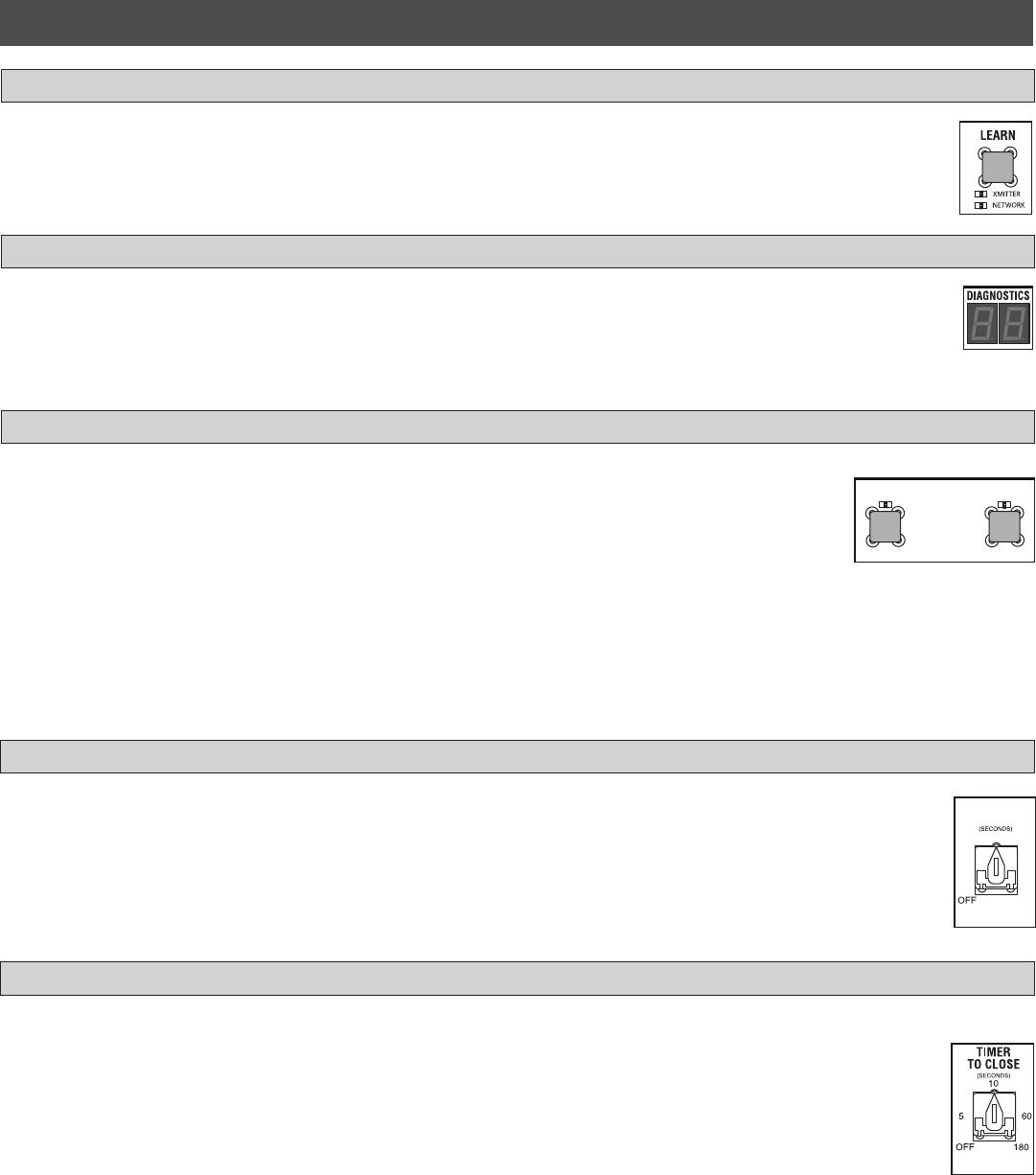
23
BIPART DELAY
TIMER-TO-CLOSE (TTC)
LEARN BUTTON
DIAGNOSTIC DISPLAY
CONTROL BOARD OVERVIEW
The diagnostic display will show the operator type, firmware version, and codes. The operator type will display as “SL” followed by a “30”
which indicates the operator type as SL3000U. The firmware version will show after the operator type, example “1.2”. For more information
about the codes refer to the Troubleshooting section.
HANDING BUTTONS
The TTC is factory set to OFF (0). Rotate the TIMER-TO-CLOSE dial to the desired setting (0 to 180 seconds).
Any radio command, single
button control, or CLOSE command on the control board prior to the TTC expiring will close the gate. The TTC is reset by any signals from
the open controls, loops, close edges, and close photoelectric sensors.
0 seconds (OFF) The gate will remain open until the operator receives another command from a control.
1-180 seconds (ON) The gate will automatically close after the specified time period.
Used in dual gate applications where a maglock, solenoid lock, or decorative overlay would require one gate to close before the other.
The BIPART DELAY is also used in applications where one gate travels a longer distance than the other.
ON The operator with the BIPART DELAY dial ON will delay from the close limit when opening and be the first to close from
the open limit.
OFF No affect.
BIPART
DELAY
2
4
6
8
The handing buttons are used to determine which direction the gate will open and they are also used to set the limits
(refer to the Adjustment section).
OPEN RIGHT If the operator is installed on the right side of the drive when looking out of the property, a swing gate
will swing to the right (turn counter clockwise) when opening and a slide gate will slide to the right when
opening.
OPEN LEFT If the operator is mounted on the left side of the drive when looking out of the property, a swing gate will swing to the left (turn
clockwise) when opening and a slide gate will slide to the left when opening.
NOTE: For gates installed on the outside of the property, the setting will be opposite. Determine the direction by looking towards the property from the
outside.
HANDING
OPEN
LEFT
OPEN
RIGHT
The LEARN button is used for programming (refer to Programming).
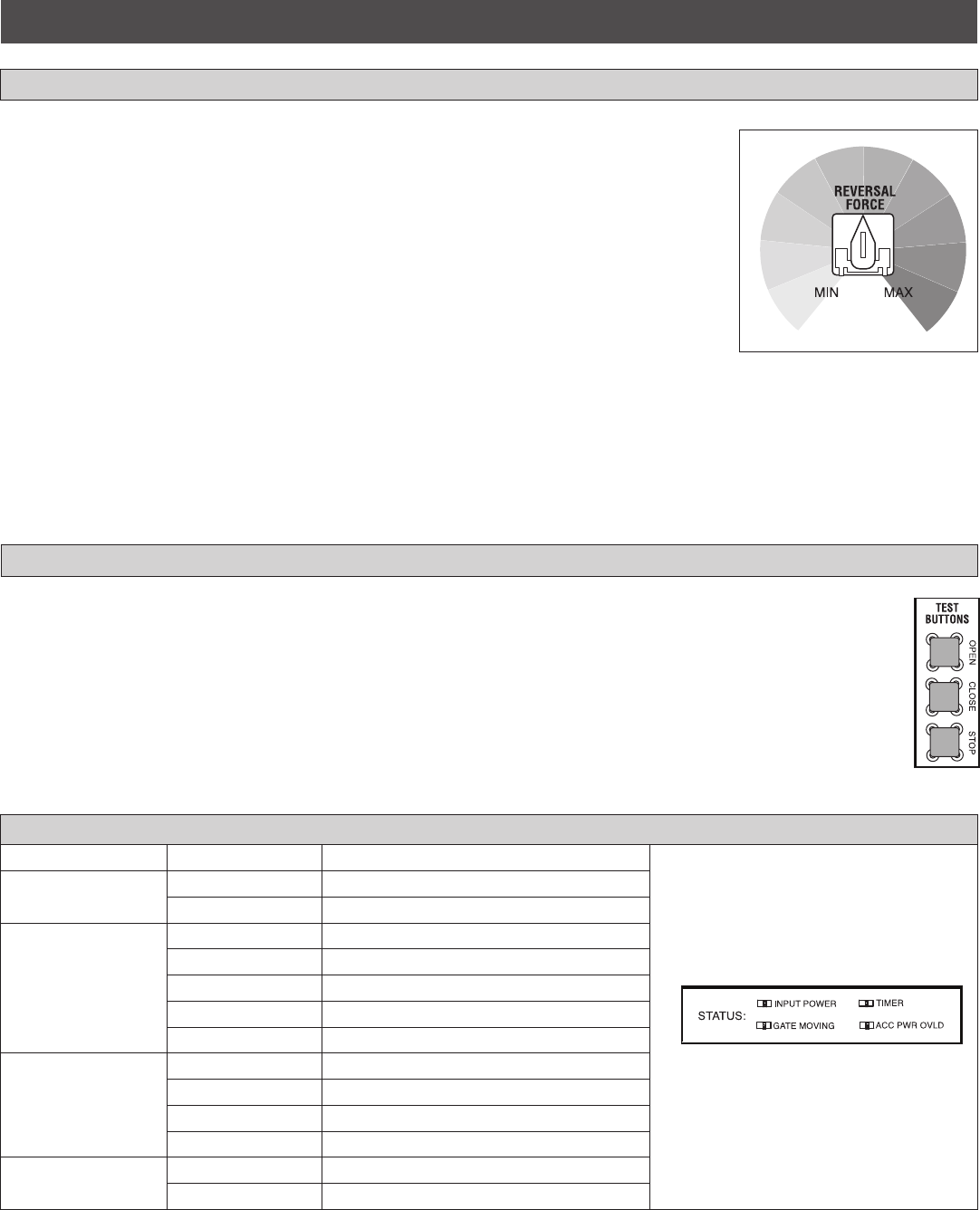
24
LED STATE DEFINITION
INPUT POWER OFF OFF state
ON AC power available
TIMER OFF The timer is disabled
ON The timer is enabled
1 blink/second The timer is running
2 blinks/second The timer is paused
8 blinks/second The timer is cancelled
GATE MOVING OFF The gate is stopped
ON The gate is opening or closing
1 blink/second E1 (single entrapment)
8 blinks/second E2 (double entrapment)
ACC PWR OVLD OFF OFF state
ON Accessory overload protector opened
STATUS LEDS
TEST BUTTONS
CONTROL BOARD OVERVIEW
FORCE DIAL
1
2
3
4
56
7
8
9
10
The force setting should be high enough that the gate will not reverse by itself nor cause nuisance
interruptions, but low enough to prevent serious injury to a person. The force setting is the same for both the
open and close gate directions.
Settings 1-3: Fixed force settings (the force will not adjust due to gate wear or temperature changes)
Settings 4-10: Automatically increase the force due to gate wear or temperature changes
ADJUST THE FORCE
1. Open and close the gate with the TEST BUTTONS, ensuring that the gate is stopping at the proper open and
close limit positions. If the gate is not stopping at the proper limits, adjust the force dial accordingly.
2. Place a solid object between the open gate and a rigid structure. Ensure that the gate, the solid object, and
the rigid structure can withstand the forces generated during this obstruction test.
3. Run the gate in the close direction. The gate should stop and reverse upon contact with the solid object. If
the gate does not reverse off the solid object, reduce the force setting by turning the force control slightly
counter-clockwise. The gate should have enough force to reach both the open and close limits, but MUST
reverse after contact with a solid object.
4. Repeat the test for the open direction.
Used to operate the gate (OPEN, STOP and CLOSE). Also used to view the code history (refer to the Troubleshooting section).
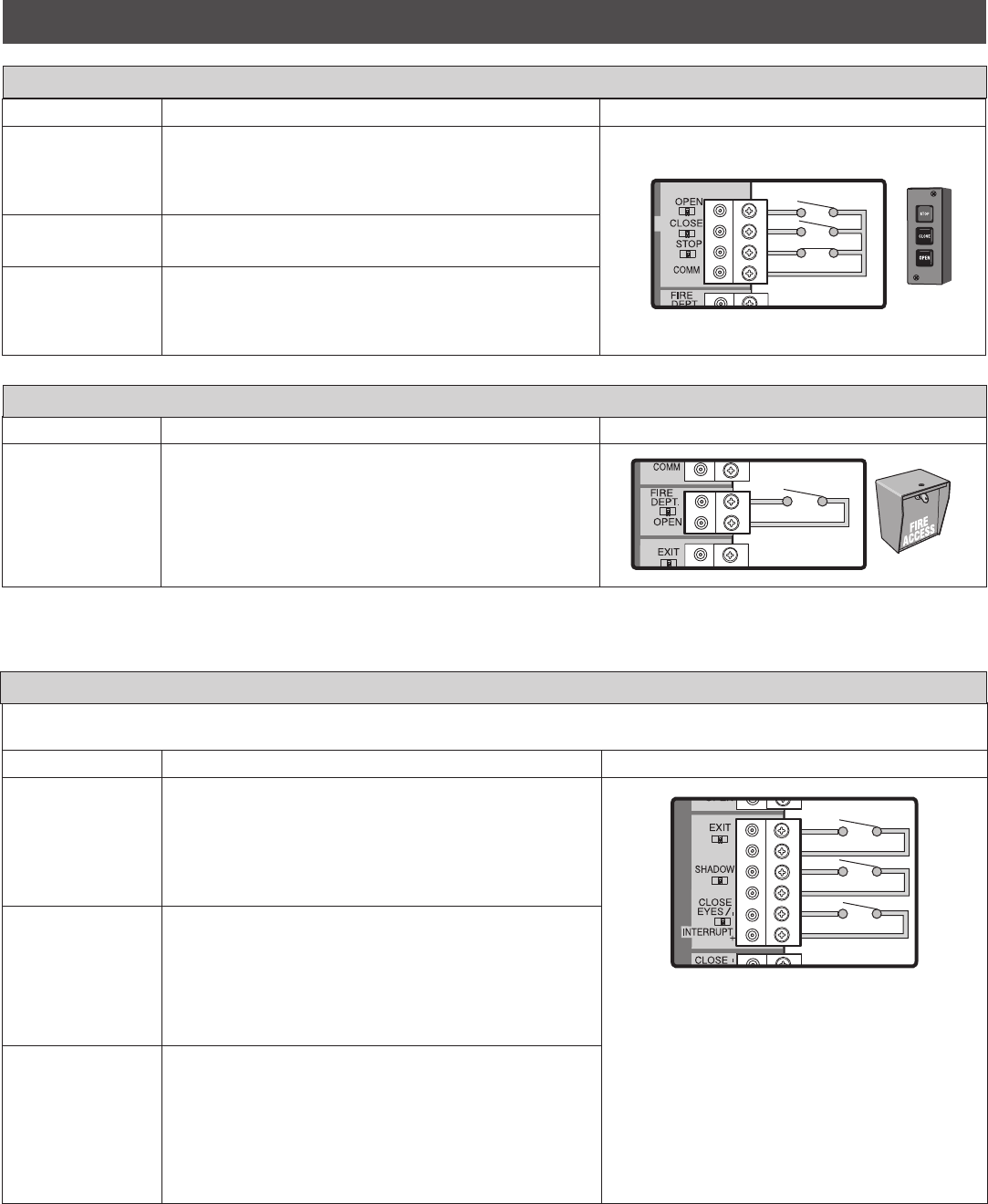
25
TERMINALS FUNCTION WIRING EXAMPLE
OPEN and COMM Opens a closed gate. Hard open (maintained switch overrides
external safeties and resets alarm condition). If maintained,
pauses Timer-to-Close at OPEN limit. Opens a closing gate and
holds open an open gate (within line-of-sight).
CLOSE and COMM Closes an open gate. Hard close (maintained switch overrides
external safeties and resets alarm condition within line-of-sight)
STOP and COMM Stops a moving gate. Hard stop (maintained switch overrides
Open and Close commands and resets alarm condition). If
maintained, cancels Timer-to-Close at OPEN limit. Overrides
Open and Close commands (within line-of-sight).
+
+
+
N.C.
–
TERMINALS FUNCTION WIRING EXAMPLE
FIRE DEPT (-) and
OPEN (+)
FIRE DEPT and OPEN terminals act as a hard open. Maintained
input overrides (ignores) external safeties (photoelectric sensor
and edge), pauses Timer-to-Close momentary input logic as
single button control and safeties remain active, re-enables
Timer-to-Close.
+
–
The Loop terminals are used for connecting loops and various control devices such as telephone entry keypads, vehicle probes, etc. Connect the
accessory to the terminals based on how the accessory should function.
TERMINALS FUNCTION WIRING EXAMPLE
EXIT and COM This input is a soft open command (maintained switch does not
override external safeties and does not reset alarm condition).
Used for exit probe, telephone entry, external exit loop detector,
or any device that would command the gate to open.
• Opens a closing gate and holds open an open gate, if
maintained, pauses Timer-to-Close at OPEN limit.
+
+
+
–
–
–
SHADOW and COM This input is used for external shadow loop detector when loop
is positioned under the swing of the gate.
• Holds open gate at open limit
• Only active when the gate is at the OPEN limit, disregarded at
all other times
• Pauses Timer-to-Close at OPEN limit
INTERRUPT and COM This input is used for photoelectric sensors and external
interrupt loop detector when loop is on the outside of the gate.
• Holds open gate at open limit
• Stops and reverses a closing gate to open limit
• Pauses Timer-to-Close at OPEN limit, activates quick close
and anti-tailgate features when enabled on the expansion
board
WIRE ACCESSORIES TO CONTROL BOARD
LOOPS
FIRE DEPARTMENT
THREE BUTTON CONTROL STATION
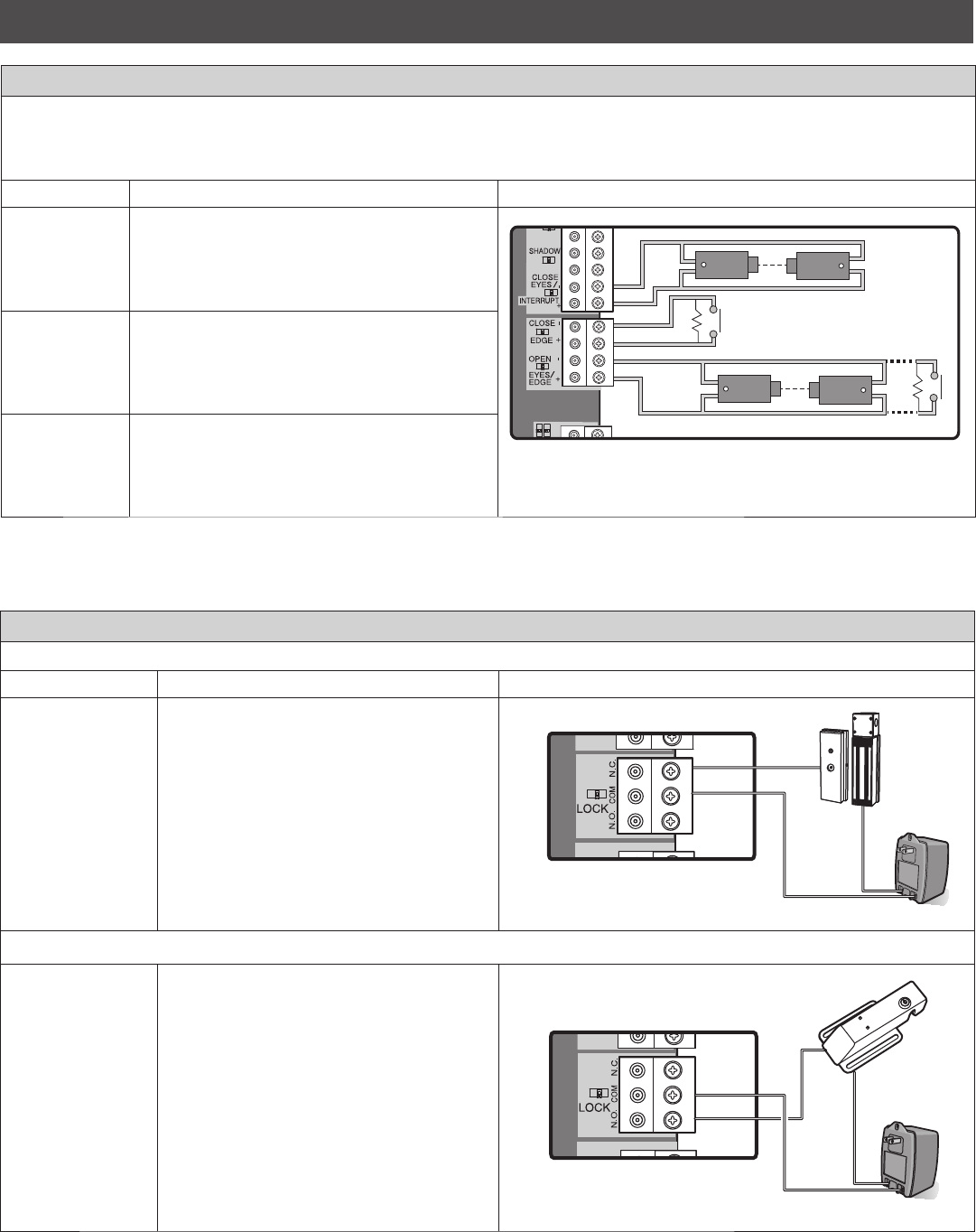
26
MAGLOCK WIRING
TERMINALS FUNCTION WIRING EXAMPLE
NC and COM Normally Closed (N.C.) output for maglocks. Relay
activates prior to motor activation and during
motor run. Relay is off when motor is off.
CO
L
B
PLY
AX
-
+
SOLENOID LOCK WIRING
NO and COM Normally Open (N.O.) output for solenoid locks.
Relay activates prior to motor activation and
during motor run. Relay is off when motor is off.
CO
L
B
PLY
AX
-
+
The EYES/EDGE terminals are used for connecting entrapment protection devices. At least one external monitored entrapment protection device is
required prior to gate movement.
Monitored entrapment protection devices should have been installed with the operator at the time of installation.
Only ONE monitored device may be connected to each input. A monitored device sends a pulsed signal to the operator so the operator is aware of
the device. If the operator does not receive the signal from the device indicating it is working properly, it will not run in that direction.
TERMINALS FUNCTION WIRING EXAMPLE
CLOSE EYES/
INTERRUPT
The CLOSE EYES/INTERRUPT input is for close
direction photoelectric sensors. When an obstruction
is sensed during gate closing the gate will open to the
full open position. This input will be disregarded
during gate opening and resets the Timer-to-Close.
+
+
+
–
–
–
M
K
A
CLOSE EDGE The CLOSE EDGE input is for the close direction edge
sensors. When an obstruction is sensed during gate
closing the gate will reverse to the full open position,
disengaging the Timer-to-Close. This input will be
disregarded during gate opening.
OPEN EYES/
EDGE
The OPEN EYES/EDGE input is for open direction
photoelectric sensors or edge sensors. When an
obstruction is sensed during gate opening the gate will
reverse for 4 seconds then stop. This input will be
disregarded during gate closing.
LOCKS
PHOTOELECTRIC SENSORS AND EDGE SENSORS
WIRE ACCESSORIES TO CONTROL BOARD
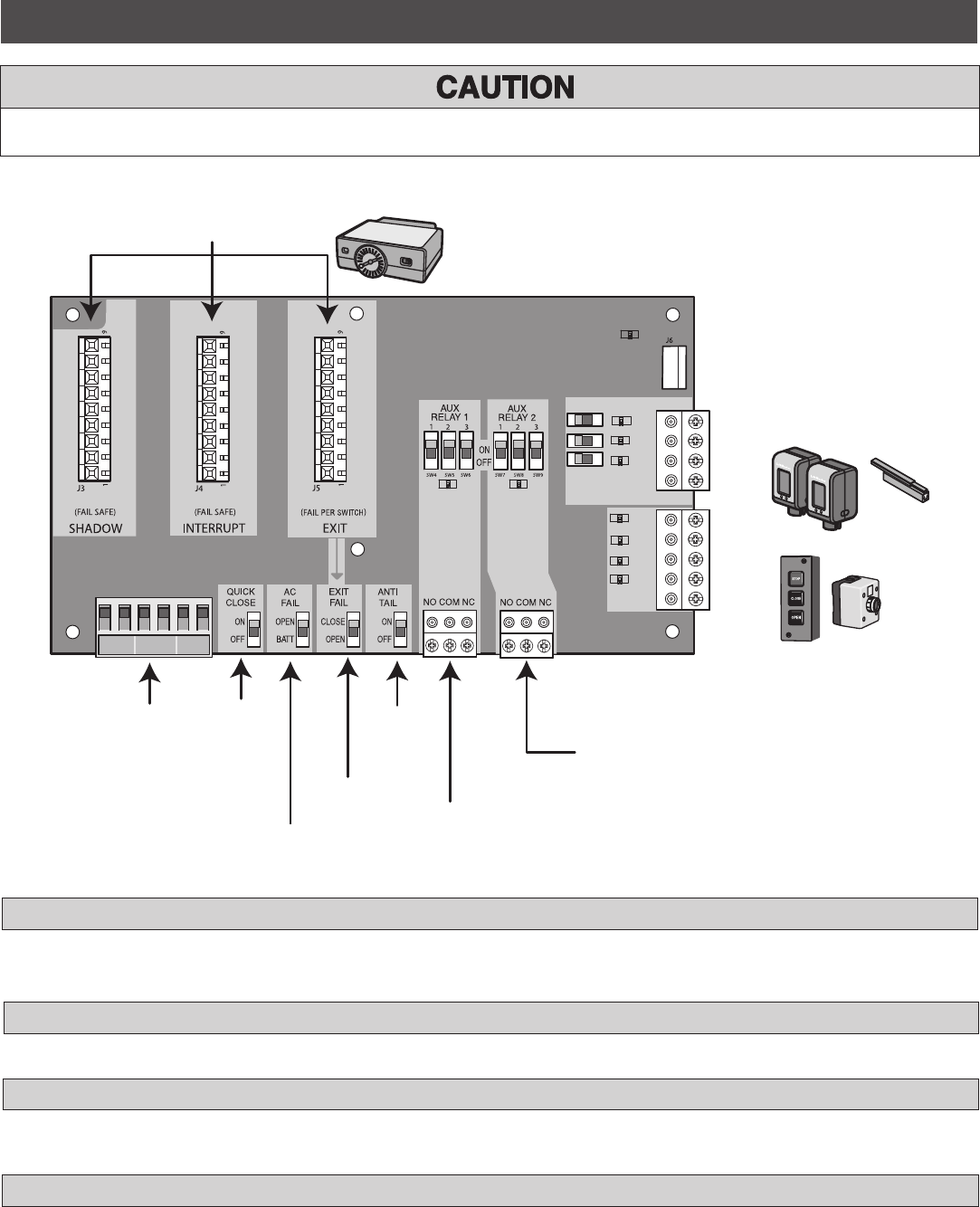
27
SHADOW INTERUPT EXIT
SBC
OPN
CLS
STP
COM
EYE
ONLY
EYE/
EDGE
EYE/
EDGE
COM
1
2
3
OPEN
CLOSE
TO MAIN
BOARD
POWER
EXPANSION BOARD OVERVIEW
To AVOID damaging the circuit board, relays or accessories, DO NOT connect more than 42 Vdc (32 Vac) to the AUX relay contact terminal blocks.
PLUG-IN LOOP DETECTOR INPUTS
For Plug-In Loop Detectors (Model LOOPDETLM)
MAIN CONTROL BOARD CONNECTION
Connected at the factory.
LOOP INPUTS
Page 30
QUICK CLOSE SWITCH
AC FAIL SWITCH
EXIT FAIL SWITCH
ANTI TAIL SWITCH
QUICK
CLOSE
SWITCH
See below.
AC FAIL SWITCH
Not used.
EXIT FAIL SWITCH
See below.
ANTI TAIL
SWITCH
See below.
RELAY 1 WITH CORRESPONDING SWITCHES
Page 28
RELAY 2 WITH CORRESPONDING SWITCHES
Page 28
EYES/EDGE TERMINALS
Page 29
CONTROL STATION TERMINALS
Page 29
NOT USED
OPEN If the EXIT plug-in loop detector (model LOOPDETLM) detects a fault, then the gate will open and remain open until fault is cleared.
CLOSE If the EXIT plug-in loop detector (model LOOPDETLM) detects a fault, faults are ignored (EXIT loop is faulted and inoperative).
OFF When CLOSE EYES/Interrupt loop is activated it causes a closing gate to stop and reverse.
ON When CLOSE EYES/Interrupt loop is activated it causes a closing gate to pause. Once the vehicle is clear the gate will continue to close.
OFF No change to the gate’s normal operation.
ON When CLOSE EYES/Interrupt loop is deactivated it causes an opening or a stopped gate to close (ignores the Timer-to-Close).
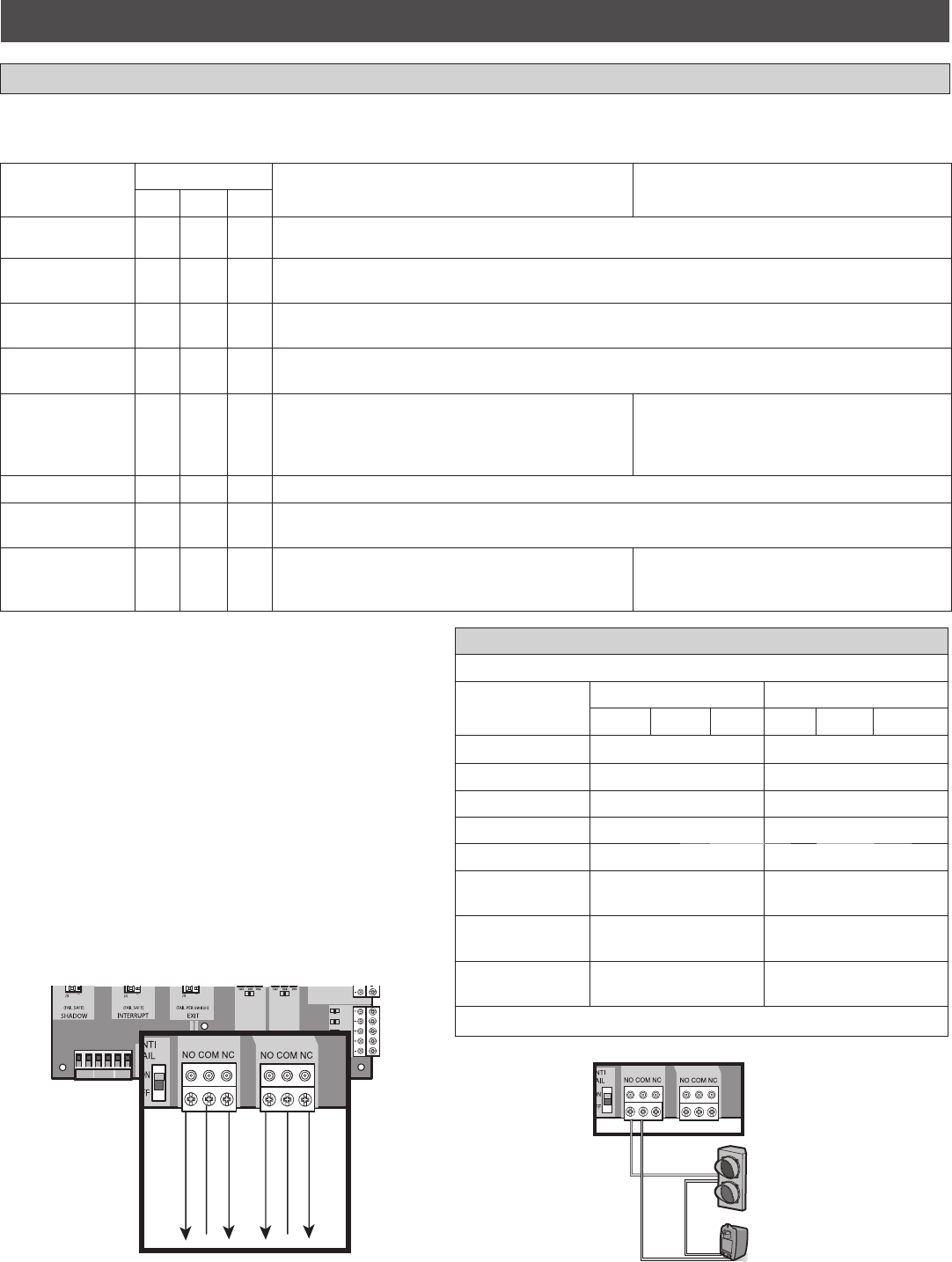
28
EXPANSION BOARD OVERVIEW
AUXILIARY RELAY 1 AND 2
RELAY SETTING SWITCH SETTINGS AUX RELAY 1 AUX RELAY 2
123
Off (no feature
selected)
OFF OFF OFF Relay always off.
Open Limit Switch OFF OFF ON Energizes at open limit. Use with SAMS (Sequenced Access Management System, jointly with barrier
gate).
Close Limit Switch OFF ON OFF Energizes when not at close limit. For an additional audible or visual display, connect an external light
(low voltage).
Gate Motion OFF ON ON Energizes when motor is on (gate in motion). For an additional audible or visual display, connect an
external buzzer or light (low voltage).
Pre-Motion Delay ON OFF OFF Energizes 3 seconds before gate motion and remains
energized during gate motion. The onboard alarm will
sound. For an additional audible or visual display,
connect an external buzzer or light (low voltage).
Energizes 3 seconds before gate motion and
remains energized during gate motion. For an
additional audible or visual display, connect an
external buzzer or light (low voltage).
Power ON ON OFF Not used.
Tamper ON OFF ON Energizes if gate is manually tampered with by being pushed off of close limit. For an additional audible
or visual display, connect an external buzzer or light (low voltage).
Cycle Quantity
Feedback*
ON ON ON The 1, 2, and 3 LEDs will blink out the cycle count
(cycle count is stored on the control board). See
below.
Not used.
SHADOW INTERUPT EXIT
SBC
OPN
CLS
STP
COM
COM
OPEN
CLOSE
AUX RELAY 1 AUX RELAY 2
A
UX Relay 2 N.C.
Com
AUX Relay 2 N.O.
AUX Relay 1 N.C.
Com
AUX Relay 1 N.O.
+
–
Traffic Light
Class 2 Power Source
(42 Vdc [34 Vac], 5 A maximum)
Normally Open (N.O.) and Normally Closed (N.C.) relay contacts to control external devices, for connection of Class 2, low voltage (42 Vdc [34 Vac] max 5
Amps) power sources only. Function of relay contact activation determined by switch settings.
CYCLE COUNT
* First, note the current Aux Relay switch positions. To determine
the actual cycles that the gate operator has run (in thousands),
set all three Aux Relay switches to the ON setting for Aux Relay
1. The Expansion Board’s 1, 2, and 3 LEDs will blink out the
cycle count, with 1 LED blinking 1000’s, 2 LED blinking
10,000’s, 3 LED blinking 100,000’s, and simultaneously all
three LED’s blink 1,000,000’s (e.g. 1 LED blinks 3 times, 2 LED
blinks 6 times, and 3 LED blinks once. Cycle count is 163,000.).
Cycle count displayed is between 1,000 and 9,999,000 cycles.
After servicing, set Aux Relay switches back to their appropriate
positions. Cycle count cannot be reset or changed. If under
1,000 cycles the 1, 2, and 3 LEDs will turn on for 10 seconds,
then turn off.
NOTE:
The expansion board will flash the cycle count 3 times
then all the LEDs will turn on solid for 10 seconds then turn off.
AUXILIARY RELAY WIRING EXAMPLE
RED/GREEN LIGHT FUNCTIONALITY
Red light wired to AUX RELAY 1. Green light wired to AUX RELAY 2.
GATE STATE AUX RELAY 1 SWITCHES AUX RELAY 2 SWITCHES
1 OFF 2 OFF 3 OFF 1 ON 2 ON 3 ON
Closed Red light OFF* Green light OFF
Opening Red light ON/Flash Green light OFF
Open Red light OFF Green light ON
Closing Red light ON/Flash Green light OFF
Defined Mid Stop n/a n/a
Undefined Mid
Stop Red light ON Green light OFF
Timer more than 5
seconds Red light OFF Green light ON
Timer less than 5
seconds Red light ON/Flash Green light OFF
* For red light ON when gate is closed, set switch 1 on AUX RELAY 1 to ON
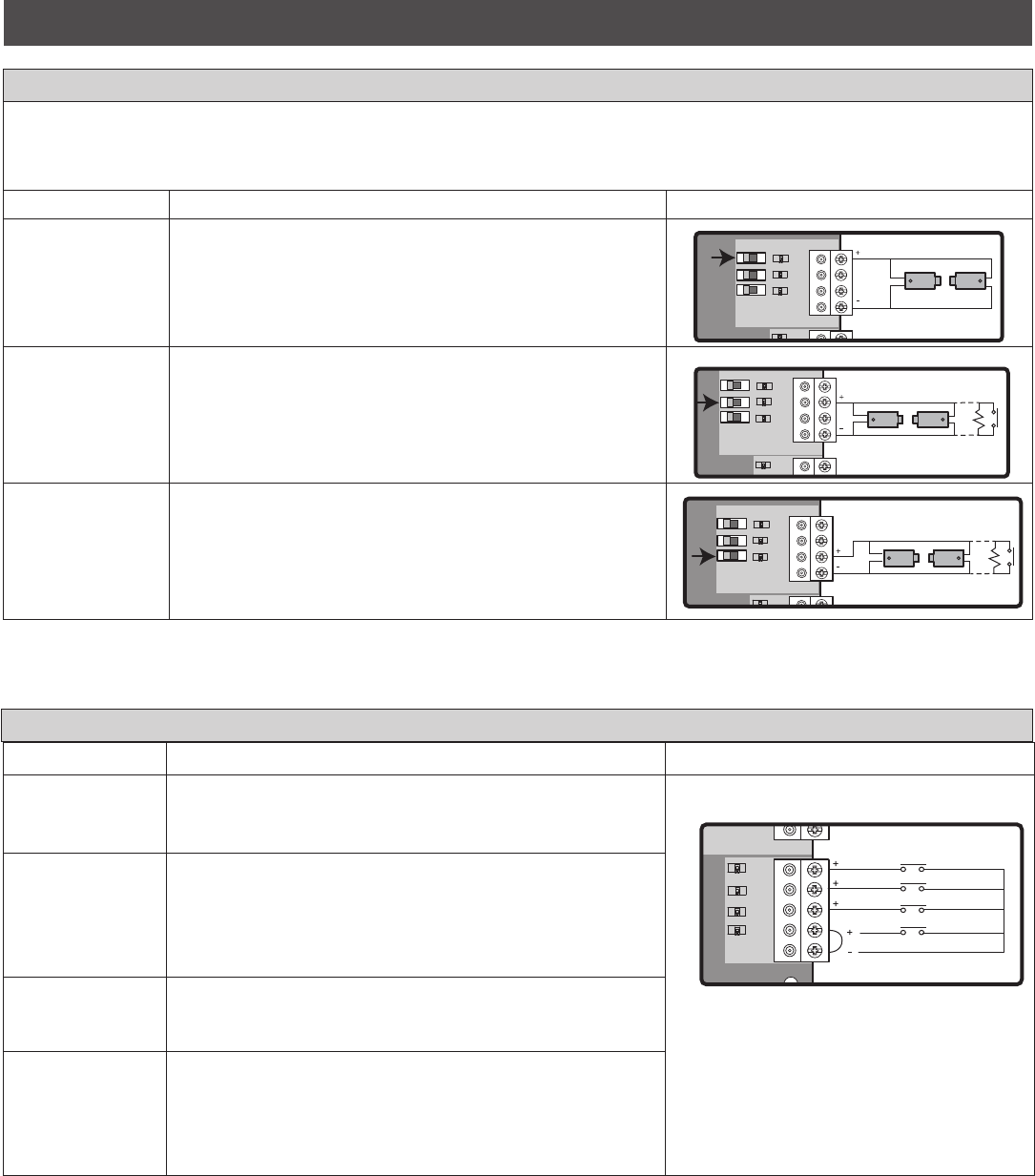
29
TERMINALS FUNCTIONALITY WIRING EXAMPLE
SBC and COM • Gate command sequence - Open, Stop, Close, Stop, ...
• Soft Open ,Soft Close, Soft Stop (maintained switch does not
override external safeties and does not reset alarm condition)
OPEN and COM • Open command - opens a closed gate
• Soft open (maintained switch does not override external safeties and
does not reset alarm condition)
• If maintained, pauses Timer-to-Close at OPEN limit
• Opens a closing gate and holds open an open gate
CLOSE and COM • Close command - closes an open gate
• Soft close (maintained switch does not override external safeties and
does not reset alarm condition)
STOP and COM • Stop command - stops a moving gate
• Hard stop (maintained switch overrides Open and Close commands
and resets alarm condition)
• If maintained, pauses Timer-to-Close at OPEN limit
• Overrides an Open or Close command
SBC
OPN
CLS
STP
COM
COM
O
CLOSE
The EYES/EDGE terminals are used for connecting entrapment protection devices. At least one external monitored entrapment protection device is
required prior to gate movement.
Monitored entrapment protection devices should have been installed with the operator at the time of installation.
Only ONE monitored device may be connected to each input. A monitored device sends a pulsed signal to the operator so the operator is aware of
the device. If the operator does not receive the signal from the device indicating it is working properly, it will not run in that direction.
TERMINALS FUNCTIONALITY WIRING EXAMPLE
EYE ONLY and COM Open or Close Direction Photoelectric Sensors, the functionality is based
on the switch settings (located next to the terminals)
Switch set to CLOSE: gate reverses fully when an obstruction is sensed
Switch set to OPEN: gate reverses 4 seconds when an obstruction is
sensed
EYE/EDGE and COM Open or Close Direction Photoelectric Sensors or Edge Sensor, the
functionality is based on the switch settings (located next to the
terminals)
Switch set to CLOSE: gate reverses fully when an obstruction is sensed
Switch set to OPEN: gate reverses 4 seconds when an obstruction is
sensed
EYE/EDGE and COM Open or Close Direction Photoelectric Sensors or Edge Sensor, the
functionality is based on the switch settings (located next to the
terminals)
Switch set to CLOSE: gate reverses fully when an obstruction is sensed
Switch set to OPEN: gate reverses 4 seconds when an obstruction is
sensed
SBC
EYE
ONLY
EYE/
EDGE
EYE/
EDGE
COM
1
2
3
OPEN
CLOSE
T
SBC
EYE
ONLY
EYE/
EDGE
EYE/
EDGE
COM
1
2
3
OPEN
CLOSE
SBC
EYE
ONLY
EYE/
EDGE
EYE/
EDGE
COM
1
2
3
OPEN
CLOSE
T
WIRE ACCESSORIES TO EXPANSION BOARD
CONTROL STATION
PHOTOELECTRIC SENSORS AND EDGE SENSORS
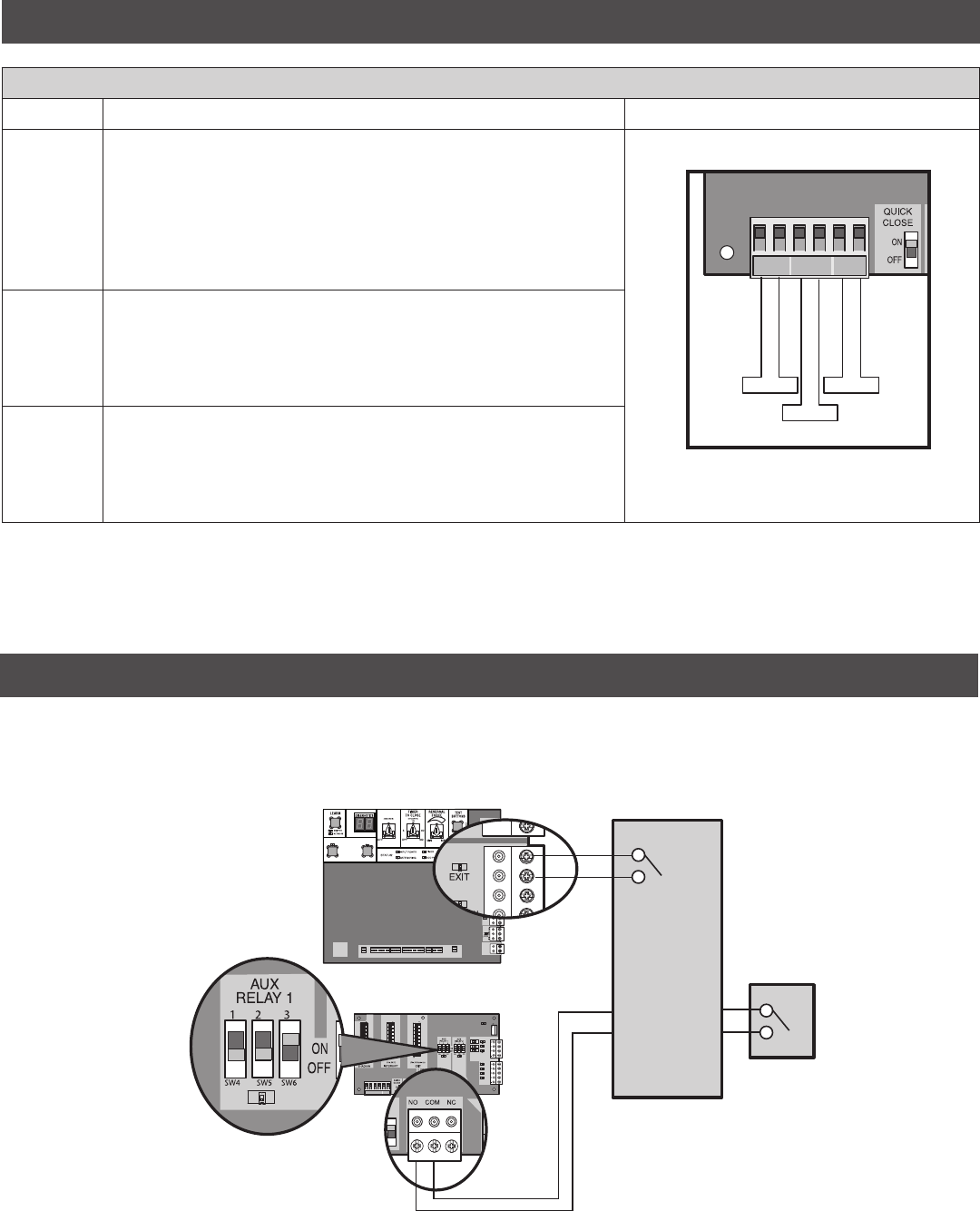
30
INPUTS FUNCTIONALITY WIRING EXAMPLE
EXIT Loop wire connection for plug-in loop detector when loop is inside secured area
near gate.
• Open command - opens a closed gate
• Soft open (maintained switch does not override external safeties and does
not reset alarm condition)
• If maintained, pauses Timer-to-Close at OPEN limit
• Opens a closing gate and holds open an open gate
SHADOW Loop wire connection for plug-in loop detector when loop is positioned under
the gate.
• Holds open gate at open limit
• Disregarded during gate motion
• Pauses Timer-to-Close at Open Limit
INTERRUPT Loop wire connection for plug-in loop detector when loop is on the outside of
the gate.
• Holds open gate at open limit
• Stops and reverses a closing gate
• Pauses Timer-to-Close at Open Limit
SHADOW INTERUPT EXIT
Exit Loop
Interrupt Loop
Shadow Loop
WIRE ACCESSORIES TO EXPANSION BOARD
LOOPS
SAMS WIRING WITH RELAYS NOT ENERGIZED
ADDITIONAL WIRING
COMM
LINK
BA
BIPART
DELAY
2
4
6
8
HANDING
OPEN
LEFT
OPEN
RIGHT
ANTENNA CURRENT
SENSOR
MOTOR DRIVE RPM & LIMITS ALARM EXP.
BOARD
24 VAC IN
CLASS 2 SUPPLY
24 VAC
500 mA MAX
ID RESET
GND
SHADOW INTERUPT EXIT
SBC
OPN
CLS
STP
COM
EYE
ONLY
EYE/
EDGE
EYE/
EDGE
COM
1
2
3
OPEN
CLOSE
DEVICE INPUTS
TO MAIN
BOARD
POWER
Access Device
Exit Input
Shadow Input
AUX Relay 1
C
NO
Auxiliary
Command
Dipswitch settings for AUX
Relay 1: 1-OFF, 2-OFF, 3-ON
Control Board
Expansion Board
Barrier Arm Operator
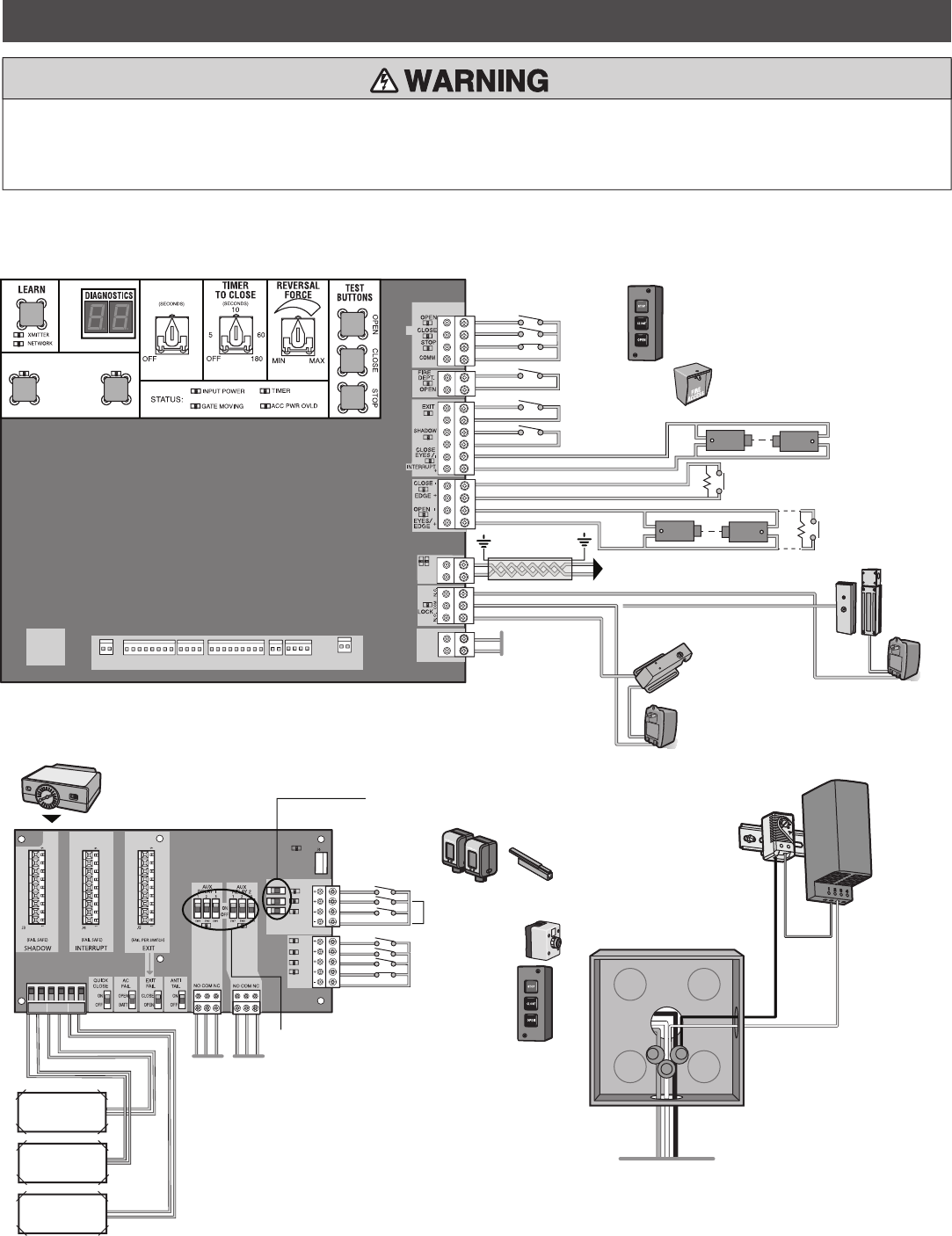
31
N.O.
COM
N.C.
N.O.
COM
N.C.
–
+
+
+
–
+
+
+
+
SHADOW INTERUPT EXIT
SBC
OPN
CLS
STP
COM
EYE
ONLY
EYE/
EDGE
EYE/
EDGE
COM
1
2
3
OPEN
CLOSE
TO MAIN
BOARD
POWER
N.C.
N.O.
COM
–
+
+
+
+
+
+
+
+
+
+
–
–
–
–
–
–
–
COMM
LINK
BA
BIPART
DELAY
2
4
6
8
HANDING
OPEN
LEFT
OPEN
RIGHT
ANTENNA CURRENT
SENSOR
MOTOR DRIVE RPM & LIMITS ALARM EXP.
BOARD
24 VAC IN
CLASS 2 SUPPLY
24 VAC
500 mA MAX
ID RESET
GND
Maglock
(Optional)
Solenoid Lock
(Optional)
OR
Shielded Twisted Pair Cable (Primary/Secondary
link to other gate operator) Ground the shield of the
cable to the chassis ground of each operator.
ACCESSORY
POWER
24 Vac 500 mA
Maximum
(Not Provided)
(Not Provided)
N.C.
INTERRUPT LOOP or
PHOTOELECTRIC SENSORS for CLOSE cycle
EDGE SENSOR for CLOSE cycle
EDGE SENSOR or
PHOTOELECTRIC SENSORS
for OPEN cycle
SHADOW LOOP
EXIT LOOP
FIRE DEPARTMENT
3-BUTTON
CONTROL
STATION
CONTROL BOARD
HEATER
SHADOW LOOP
EXIT LOOP
INTERRUPT
LOOP
AUXILIARY
RELAY 2
AUXILIARY
RELAY 1
SINGLE BUTTON
CONTROL STATION
3-BUTTON
CONTROL STATION
PHOTOELECTRIC SENSORS
PHOTOELECTRIC SENSORS or
EDGE SENSORS
NOTE: These switches determine if the
corresponding photoelectric sensor or edge
sensor will function for the OPEN or CLOSE cycle.
PLUG-IN LOOP DETECTOR
Model LOOPDETLM
NOTE: These switches control how
the Auxiliary Relays will function.
EXPANSION BOARD
JUNCTION BOX
L
N
GND
Incoming Power
N.C.
To protect against fire and electrocution:
• DISCONNECT power BEFORE installing or servicing operator.
For continued protection against fire:
• Replace ONLY with fuse of same type and rating.
ADDITIONAL WIRING
FIELD WIRING

32
PROGRAMMING
REMOTE CONTROLS (NOT PROVIDED)
OPTION DESCRIPTION PROGRAMMING STEPS
Single button as OPEN
only
Program a single button on the
remote control for open only. The
Timer-to-Close can be set to close
the gate.
1. Press and release the LEARN button (operator will beep and green XMITTER
LED will light).
NOTE:
The operator will time out of programming mode after 30
seconds.
2. Press the OPEN button.
3. Press the remote control button that you would like to program.
Single button (SBC) as
OPEN, CLOSE, and
STOP
Program one remote control button
as an open, close, and stop.
1. Press and release the LEARN button (operator will beep and green XMITTER
LED will light).
NOTE:
The operator will time out of programming mode after 30
seconds.
2. Press the remote control button that you would like to program.
Three separate buttons
as OPEN, CLOSE, and
STOP
Program each remote control button
as an open, close, and stop.
1. Press and release the LEARN button (operator will beep and green XMITTER
LED will light).
NOTE:
The operator will time out of programming mode after 30
seconds.
2. Press the OPEN, CLOSE, or STOP button, depending on the desired function.
3. Press the remote control button that you would like to program.
NOTICE: This device complies with part 15 of the FCC rules and Industry Canada (IC) licence-exempt RSS standard(s). Operation is subject to the following two conditions: (1) this device may not cause harmful interference,
and (2) this device must accept any interference received, including interference that may cause undesired operation.
Any changes or modifications not expressly approved by the party responsible for compliance could void the user’s authority to operate the equipment.
This Class B digital apparatus complies with Canadian ICES-003.
This device has been tested and found to comply with the limits for a Class B digital device, pursuant to part 15 of the FCC rules. These limits are designed to provide reasonable protection against harmful interference in a
residential installation. This equipment generates, uses and can radiate radio frequency energy and, if not installed and used in accordance with the instructions, may cause harmful interference to radio communications.
However, there is no guarantee that interference will not occur in a particular installation. If this equipment does cause harmful interference to radio or television reception, which can be determined by turning the equipment
off and on, the user is encouraged to try to correct the interference by one or more of the following measures:
- Reorient or relocate the receiving antenna.
- Increase the separation between the equipment and receiver.
- Connect the equipment into an outlet on a circuit different from that to which the receiver is connected.
- Consult the dealer or an experienced radio/TV technician for help.
A total of 50 Security+
2.0™ remote controls and 2 keyless entries (1 PIN for each keyless entry) can be programmed to the operator. When
programming a third keyless entry to the operator, the first keyless entry will be erased to allow the third keyless entry to be programmed. When the
operator’s memory is full it will exit the programming mode and the remote control will not be programmed. The memory will need to be erased
before programming any additional remote controls. NOTE: If installing an 86LM to extend the range of the remote controls DO NOT straighten the
antenna.
There are 3 different options for programming the remote control depending on how you would like the remote control to function. Choose a
programming option:
The operator will automatically exit learn mode (operator will beep and green XMITTER LED will go out) if programming is successful. To program
additional Security+ 2.0™ remote controls or remote control buttons, repeat the programming steps above.
Once the remote control has been programmed the operator will operate as follows:
When gate is in the closed position, activation of the remote control button will open the gate. During the open cycle another activation of the remote
control will stop the gate and the next activation of the remote control will close the gate. When the gate is in the open position, activation of the
remote control button will close the gate. If the remote control is activated while the gate is closing, the gate will stop and the next activation will open
the gate.
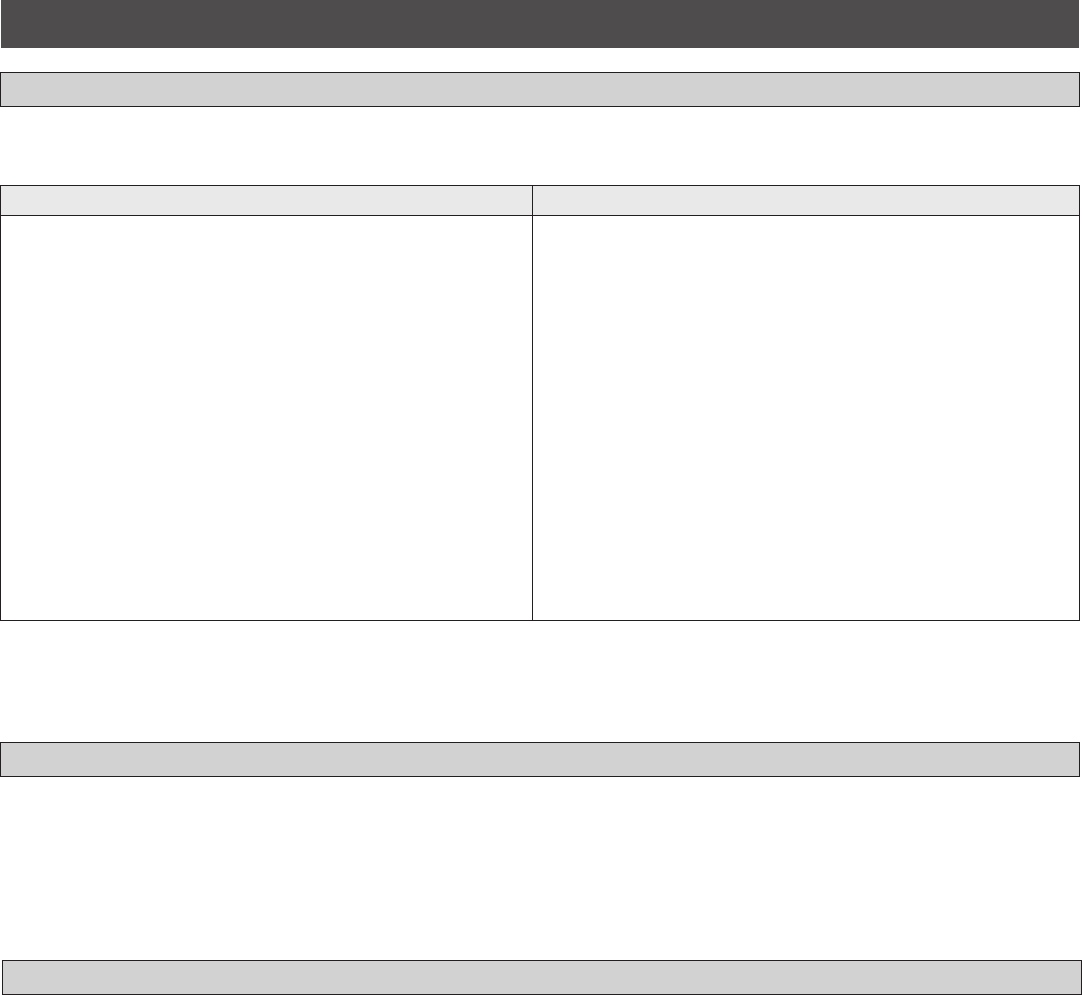
33
PROGRAMMING
ERASE ALL CODES
TO REMOVE AND ERASE ALL MONITORED ENTRAPMENT PROTECTION DEVICES
LIFTMASTER INTERNET GATEWAY (NOT PROVIDED)
Program using the learn button on the operator's control board: Program using the reset button on the operator:
1. Connect the ethernet cable to the LiftMaster Internet Gateway and
the router.
2. Connect power to the LiftMaster Internet Gateway.
3. Create an online account by visiting www.myliftmaster.com.
4. Register the LiftMaster Internet Gateway.
5. Use an internet enabled computer or smartphone to add devices.
The LiftMaster Internet Gateway will stay in learn mode for three
minutes.
6. Press the Learn button twice on the primary operator (the operator
will beep as it enters learn mode). The LiftMaster Internet Gateway
will pair to the operator if it is within range and the operator will
beep if programming is successful.
1. Connect the ethernet cable to the LiftMaster Internet Gateway and the
router.
2. Connect power to the LiftMaster Internet Gateway.
3. Create an online account by visiting www.myliftmaster.com.
4. Register the LiftMaster Internet Gateway.
5. Use an internet enabled computer or smartphone to add devices. The
LiftMaster Internet Gateway will stay in learn mode for three minutes.
6. Ensure gate is closed.
7. Give the operator an OPEN command.
8. Within 30 seconds, when the gate is at the open limit press and
release the reset button 3 times (on primary gate) to put primary
operator into High Band Learn Mode (the operator will beep as it
enters learn mode). The LiftMaster Internet Gateway will pair to the
operator if it is within range and the operator will beep if programming
is successful.
To program the operator to the LiftMaster Internet Gateway:
The status as shown by the LiftMaster Internet Gateway app will be either “open” or “closed”. The gate operator can then be controlled through the
LiftMaster Internet Gateway app.
1. Press and release the LEARN button (operator will beep and green XMITTER LED will light).
2. Press and hold the LEARN button again until the green XMITTER LED flashes and then release the button (approximately 6 seconds). All remote
control codes are now erased.
1. Remove the entrapment protection device wires from the terminal block.
2. Press and release the OPEN LEFT and OPEN RIGHT buttons simultaneously. The handing direction LED will remain solid. The other direction LED
will begin flashing (entering setup mode).
3. Press the OPEN LEFT and OPEN RIGHT buttons simultaneously to exit.

34
SETTINGS
GATE OPERATOR SETUP EXAMPLES
Setting RESIDENTIAL COMMERCIAL/
GENERAL ACCESS
COMMERCIAL INDUSTRIAL
Quick Close switch
setting
Normally set to OFF.
Normal gate close (timer or
control).
Normally set to OFF. Normal
gate close (timer or control).
Normally set to OFF. Normal
gate close (timer or control).
Set to ON, so that gate
closes immediately after
vehicle passes CLOSE EYES/
Interrupt loop.
Anti-Tail switch setting Normally set to OFF. CLOSE
EYES/Interrupt loop
reverses a closing gate.
Normally set to OFF. CLOSE
EYES/Interrupt loop reverses a
closing gate.
Set to ON. In attempt to
prevent vehicle tail-gating,
CLOSE EYES/Interrupt loop
pauses a closing gate.
Set to ON. In attempt to
prevent vehicle tail-gating,
CLOSE EYES/Interrupt loop
pauses a closing gate.
Bipart Delay switch
setting
For DUAL-GATE site, set to
ON for gate that delays
upon opening.
For DUAL-GATE site, set to ON
for gate that delays upon
opening.
For DUAL-GATE site, set to
ON for gate that delays upon
opening.
For DUAL-GATE site, set to
ON for gate that delays upon
opening.
Aux Relay Out – Open
Limit Switch
Typically not required. Use with SAMS (Sequence
Access Management System).
1) Use with SAMS (Sequence
Access Management
System).
2) Connect “Gate Open”
indicator (e.g. light).
1) Use with SAMS (Sequence
Access Management
System).
2) Connect “Gate Open”
indicator (e.g. light).
Aux Relay Out – Close
Limit Switch
Typically not required. Typically not required. Connect “Gate Close/Secure”
indicator (e.g. light).
Connect “Gate Close/Secure”
indicator (e.g. light).
Aux Relay Out – Gate
Motion
Attach alert signal (audible
or visual alert system).
Attach alert signal (audible or
visual alert system).
Attach alert signal (audible or
visual alert system).
Attach alert signal (audible or
visual alert system).
Aux Relay Out –
Pre-Motion Delay
Attach alert signal (audible
or visual alert system).
Attach alert signal (audible or
visual alert system).
Attach alert signal (audible or
visual alert system).
Attach alert signal (audible or
visual alert system).
Aux Relay Out – Tamper
(Slide Gates Only)
Attach alert signal (audible
or visual alert system) to
indicate if gate is manually
tampered with by being
pushed off of close limit.
Attach alert signal (audible or
visual alert system) to indicate if
gate is manually tampered with
by being pushed off of close
limit.
Attach alert signal (audible or
visual alert system) to
indicate if gate is manually
tampered with by being
pushed off of close limit.
Attach alert signal (audible or
visual alert system) to
indicate if gate is manually
tampered with by being
pushed off of close limit.
Cycle Quantity Feedback Use during servicing only to
determine operator cycles.
Use during servicing only to
determine operator cycles.
Use during servicing only to
determine operator cycles.
Use during servicing only to
determine operator cycles.
Fire Dept Open input Typically not required. Connect emergency access
system (Knox box switch, SOS
system, etc.).
Typically not required. Typically not required.
Heater Accessory
(Model HTRNB)
The heater keeps the
gearbox and batteries at a
suitable temperature when
the outside temperature is
below -4°F. The thermostat
MUST be set between 45°F
and 60°F to ensure proper
gate operation.
The heater keeps the gearbox
and batteries at a suitable
temperature when the outside
temperature is below -4°F. The
thermostat MUST be set
between 45°F and 60°F to
ensure proper gate operation.
The heater keeps the gearbox
and batteries at a suitable
temperature when the outside
temperature is below -4°F.
The thermostat MUST be set
between 45°F and 60°F to
ensure proper gate operation.
The heater keeps the gearbox
and batteries at a suitable
temperature when the
outside temperature is below
-4°F. The thermostat MUST
be set between 45°F and
60°F to ensure proper gate
operation.
The following are example setups for the gate operator. Your specific site requirements may be different. Always setup the operator system to the site
requirements, including all necessary entrapment protection devices.
RESIDENTIAL: One to four residential homes sharing a gated entrance/exit, allowing vehicle access trumps security concerns
COMMERCIAL/GENERAL ACCESS: A residential community (more than four homes) having one or more gated entrances/exits, allowing
vehicle access trumps security concerns
COMMERCIAL: Business site where security (gate closed) is important
INDUSTRIAL: Large business site where security is required
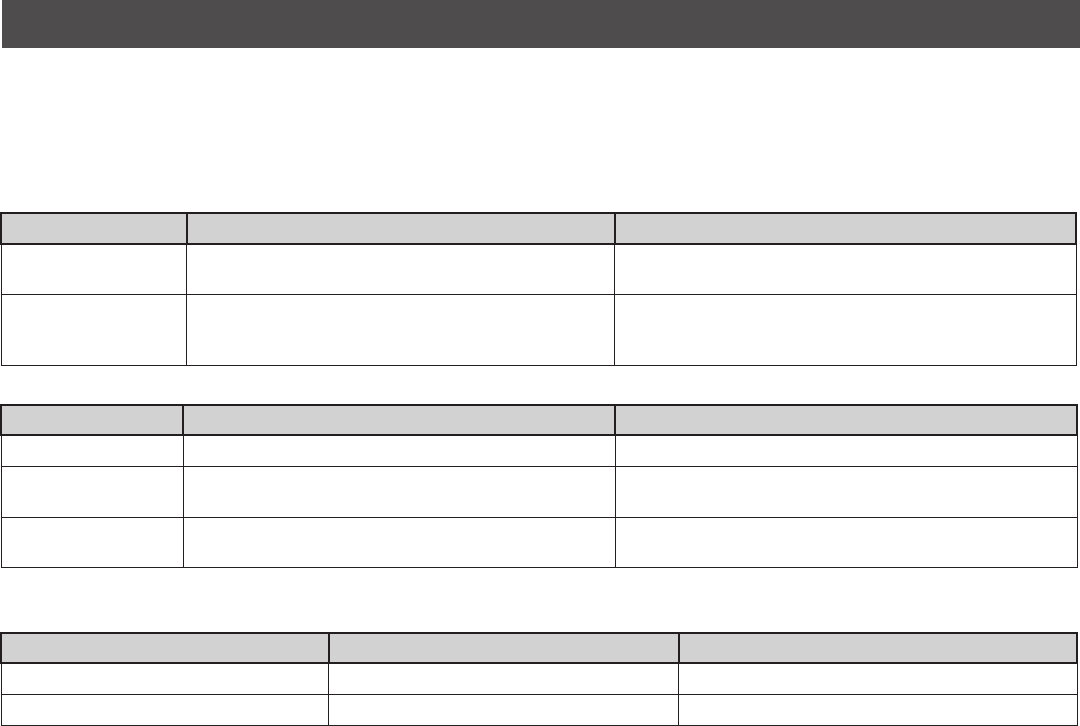
35
SETTINGS
DUAL GATE SETTINGS
FEATURE PRIMARY OPERATOR SECONDARY OPERATOR
QUICK CLOSE Switch ON OFF
ANTI-TAIL Switch ON OFF
EXPANSION BOARD
FEATURE PRIMARY OPERATOR SECONDARY OPERATOR
Timer-to-Close Set the TTC dial to desired setting OFF
Bi-Part Delay Switch Bi-Part Delay: ON (will open last and close first)
Tandem Mode: OFF
Bi-Part Delay: OFF (will open first and close last)
Tandem Mode: OFF
NOTE: We recommend that all accessories and board configurations are set on the primary operator.
MAIN CONTROL BOARD
ACCESSORY PRIMARY OPERATOR SECONDARY OPERATOR
Remote Controls Program remote controls 1 to 50 to the primary operator. Program remote controls 51 to 100 to the secondary operator
LiftMaster Internet
Gateway
Program to primary operator.
Garage and Gate
Monitor
Program to primary operator.
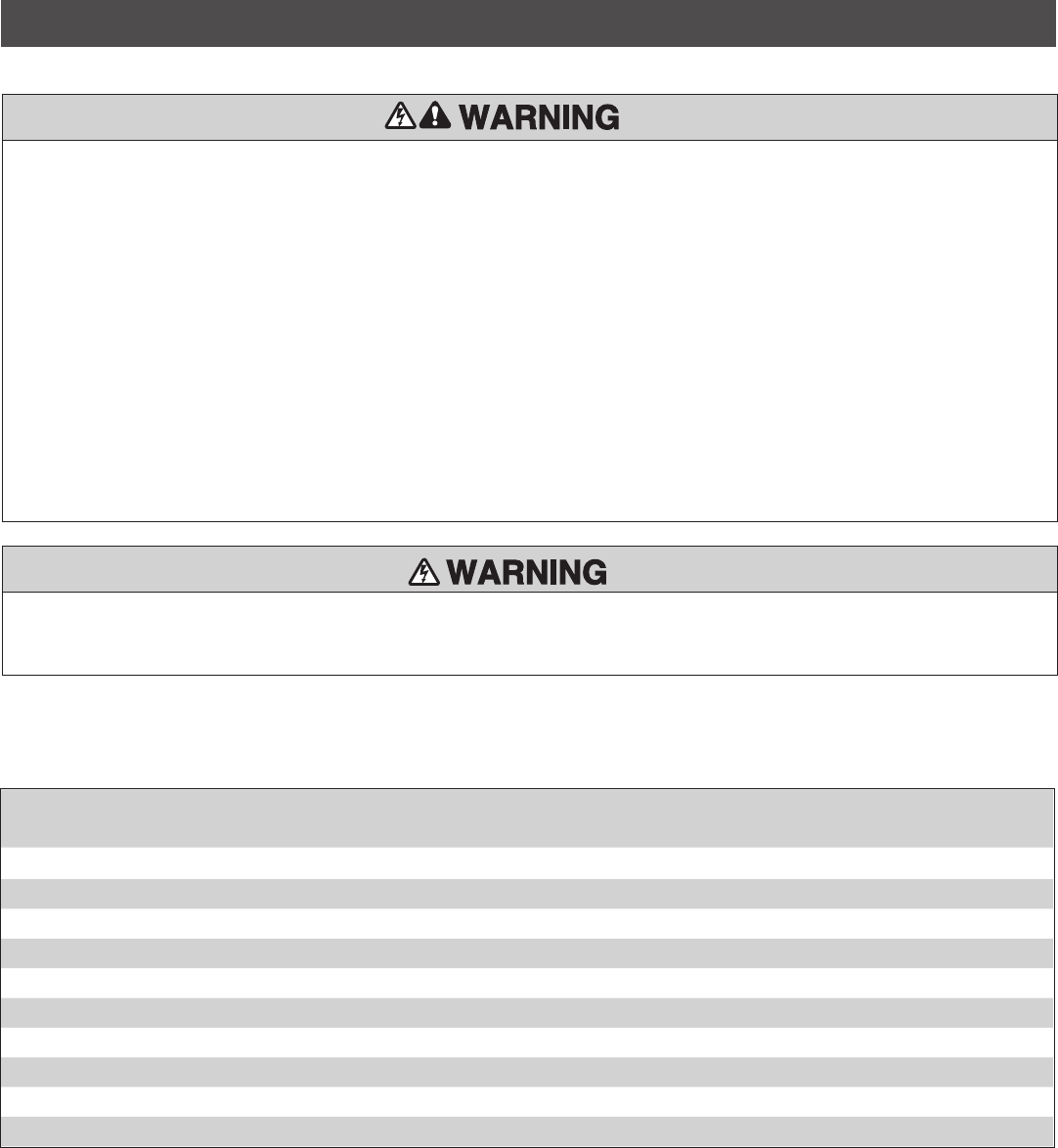
36
NOTES:
• Severe or high cycle usage will require more frequent maintenance checks.
• Limits may have to be reset after any major drive chain adjustments.
• If lubricating chain, use only lithium spray. Never use grease or silicone spray.
• Over time, the drive chain on the operator will stretch and need to be tightened. To tighten the drive chain adjust either of the two chain eye bolts.
The chain should have no more than 1 inch of sag for every 10 feet of chain length.
• It is suggested that while at the site voltage readings be taken at the operator. Using a digital voltmeter, verify that the incoming voltage to the
operator is within ten percent of the operator’s rating.
MAINTENANCE
Disconnect all power to the operator before servicing.
DESCRIPTION TASK
CHECK AT LEAST ONCE EVERY
MONTH 6 MONTHS
Entrapment Protection Devices Check and test for proper operation X
Warning Signs Make sure they are present X
Manual Disconnect Check and test for proper operation X
Drive Chain and Sprockets Check for excessive slack and lubricate X
Belt and Pulley Check for excessive slack, wear or damage X
Gate Inspect for wear or damage X
Accessories Check all for proper operation X
Electrical Inspect all wire connections X
Chassis Mounting Bolts Check for tightness X
Operator Inspect for wear or damage X
MAINTENANCE
To reduce the risk of SEVERE INJURY or DEATH:
• READ AND FOLLOW ALL INSTRUCTIONS.
• ANY maintenance to the operator or in the area near the operator
MUST NOT be performed until disconnecting the electrical power (AC
or solar and battery) and locking-out the power via the operator
power switch. Upon completion of maintenance the area MUST be
cleared and secured, at that time the unit may be returned to service.
• Disconnect power at the fuse box BEFORE proceeding. Operator
MUST be properly grounded and connected in accordance with
national and local electrical codes.
NOTE:
The operator should be on
a separate fused line of adequate capacity.
• NEVER let children operate or play with gate controls. Keep the
remote control away from children.
• ALWAYS keep people and objects away from the gate. NO ONE
SHOULD CROSS THE PATH OF THE MOVING GATE.
• The entrance is for vehicles ONLY. Pedestrians MUST use separate
entrance.
• Test the gate operator monthly. The gate MUST reverse on contact
with a rigid object or reverse when an object activates the non-
contact sensors. After adjusting the force or the limit of travel, retest
the gate operator. Failure to adjust and retest the gate operator
properly can increase the risk of INJURY or DEATH.
• Use the manual disconnect release ONLY when the gate is NOT
moving.
• KEEP GATES PROPERLY MAINTAINED. Read the owner’s manual.
Have a qualified service person make repairs to gate hardware.
• ALL maintenance MUST be performed by a LiftMaster professional.
• Activate gate ONLY when it can be seen clearly, is properly adjusted
and there are no obstructions to gate travel.
• SAVE THESE INSTRUCTIONS.
IMPORTANT SAFETY INFORMATION
To protect against fire and electrocution:
• DISCONNECT power (AC or solar and battery) BEFORE installing or
servicing operator.
For continued protection against fire:
• Replace ONLY with fuse of same type and rating.
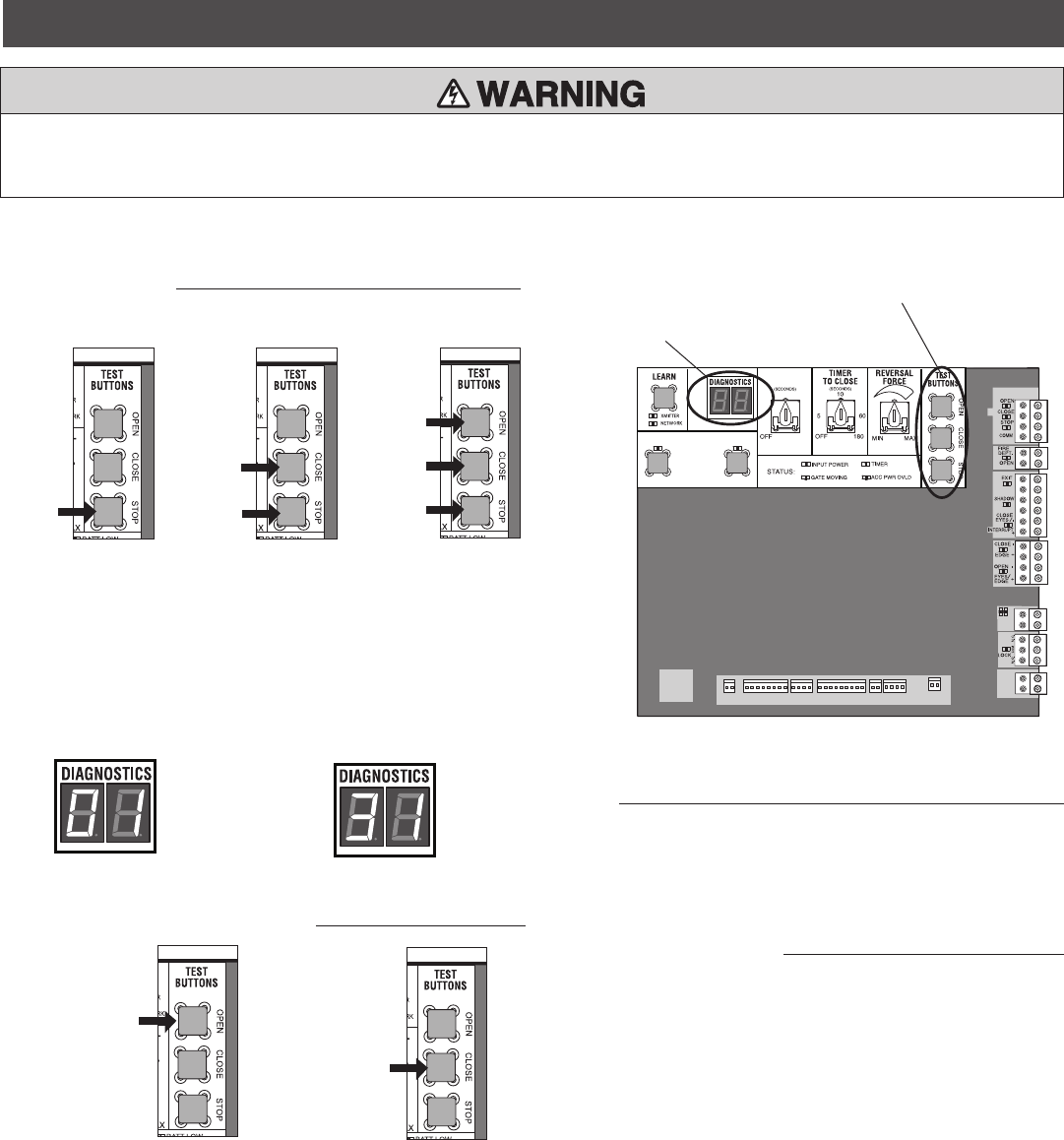
37
TROUBLESHOOTING
DIAGNOSTIC CODES
Press and
hold the
STOP
button...
...then press
and hold the
CLOSE button...
TO VIEW THE CODES
The codes will show on the diagnostic display.
TO SCROLL THROUGH THE SAVED CODES
Press the OPEN button
to cycle to the most
recent code ("01").
Press the CLOSE button
to cycle to the oldest
code (up to "20").
A SECOND
LATER....
The operator will only keep track of up to 20 codes, then will start saving
over the oldest codes as new codes occur.
The operator will show the code sequence number followed by the code
number:
COMM
LINK
BA
BIPART
DELAY
2
4
6
8
HANDING
OPEN
LEFT
OPEN
RIGHT
ANTENNA CURRENT
SENSOR
MOTOR DRIVE RPM & LIMITS ALARM EXP.
BOARD
24 VAC IN
CLASS 2 SUPPLY
24 VAC
500 mA MAX
ID RESET
GND
DIAGNOSTICS DISPLAY
OPEN, CLOSE, & STOP BUTTONS
...then press
and hold the
OPEN button
until "Er"
shows on
the display.
CODE NUMBER
The second number shown after the
code sequence number is the code
itself (31-99, example" "31"). Refer to
the chart on the following page for an
explanation of each code.
CODE SEQUENCE NUMBER
The first number shown is the most
recent code (example: "01"). The
display will show the sequence of
codes that occurred starting with "01"
and going up to code "20".
TO EXIT
Press and release the STOP button to exit. The display will also time out
after two minutes of inactivity.
TO RESET THE CODE HISTORY
1. Press and hold the STOP button for six seconds. The display will
show "Er" then "CL" alternately for six seconds.
2. Release the STOP button. The code history has now been reset and
the display will show "- -" until a new code occurs.
3. Press and release the STOP button to exit.
To protect against fire and electrocution:
• DISCONNECT power (AC or solar and battery) BEFORE installing or
servicing operator.
For continued protection against fire:
• Replace ONLY with fuse of same type and rating.
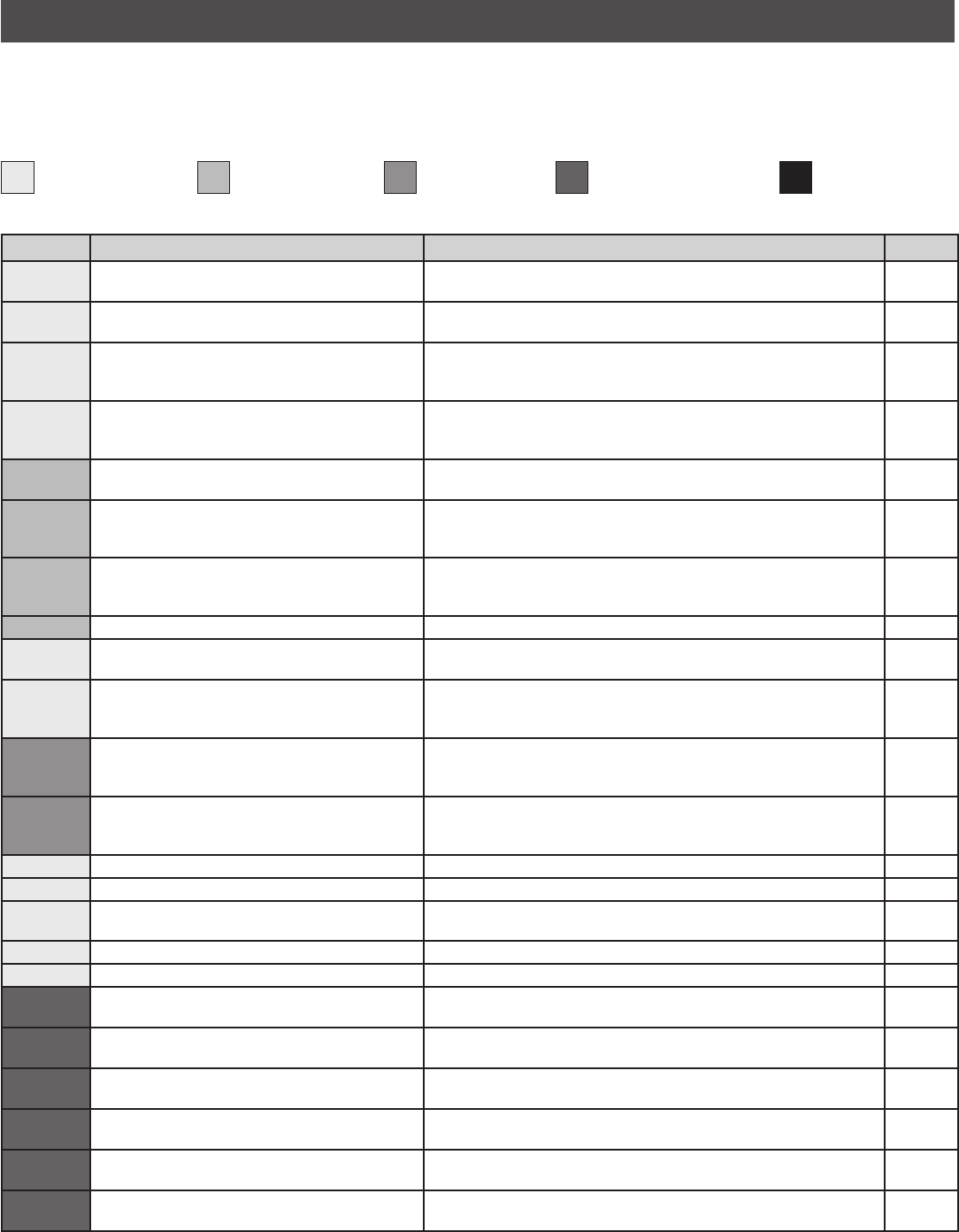
38
DIAGNOSTIC CODES continued...
TROUBLESHOOTING
Some codes are saved in the code history and some are not. If a code is not saved it will briefly appear on the display as it occurs, then disappear.
Code Meaning Solution Saved
31 Main control board has experienced an internal
failure.
Disconnect all power, wait 15 seconds, then reconnect power (reboot).
If issue continues, replace main control board.
NO
35 Max-Run-Time Exceeded Error Attempt to run and review for duration and obstructions. Max-Run-
Time can be re-measured by saving one or both of the limits again.
YES
36
Product ID Error Was the control board just replaced? If so, erase limits, enter limit
setup mode and set limits. If not, disconnect all power, wait 15
seconds, then reconnect power before changing product ID harness.
YES
37
Product ID Failure Unplug product ID harness then plug back in. Disconnect all power,
wait 15 seconds, then reconnect power before replacing product ID
harness.
YES
43 Loop Error - Failure or missing exit loop (SHORT
or OPEN - LiftMaster Plug-in Loop Detector only)
Check loop wiring throughout connection. May be a short in the loop,
or an open connection in the loop.
YES
44
Loop Error - Failure or missing shadow loop
(SHORT or OPEN - LiftMaster Plug-in Loop
Detector only)
Check loop wiring throughout connection. May be a short in the loop,
or an open connection in the loop.
YES
45
Loop Error - Failure or missing interrupt loop
(SHORT or OPEN - LiftMaster Plug-in Loop
Detector only)
Check loop wiring throughout connection. May be a short in the loop,
or an open connection in the loop.
YES
46 Wireless edge battery low Replace batteries in wireless edge. YES
47 Motor control board fault Relay fault detected in the motor control board. Replace the motor
control board.
YES
50
Run-Distance Error The limits are less than the minimum requirement or longer than what
was learned. Check limit positions and proper switch function.
Run-distance can be re-learned by setting the handing again.
YES
53
Brownout occurred AC/DC board supply dipped below allowable level. Review power
supply and wiring. If rebooting, ensure enough time for discharge of
power to force a fresh boot.
YES
54
Wireless Second Operator Communication Error Check the second operator for power. If OFF, restore power and try to
run the system. If powered, deactivate the wireless feature and then
re-learn the second operator.
YES
55 System AC Overvoltage Call utility. YES
56 System AC Undervoltage Check wiring and wire gauge to operator. YES
57 Limit Error - Stuck Switch Check switch for proper operation. Check harness for shorts. Replace
if defective.
YES
58 Limit Error - Wrong Switch Check motor wiring. YES
59 Missing Power Board Check harness for shorts. Check for presence of power board. YES
60 Minimum number of monitored entrapment
protection devices (one) not installed.
Review monitored entrapment protection device connections. NO
61 CLOSE EYE/INTERRUPT held more than 3 minutes
(main board)
Check CLOSE EYE/INTERRUPT input on main board; check for
alignment or obstruction.
YES
62 CLOSE EDGE held more than 3 minutes (main
board)
Check CLOSE EDGE input on main board; check for alignment or
obstruction.
YES
63 OPEN EYE/EDGE held more than 3 minutes (main
board)
Check OPEN EYE/EDGE input on main board; check for alignment or
obstruction.
YES
64 CLOSE EYE/INTERRUPT held more than 3 minutes
(expansion board)
Check wired input on expansion board; check for alignment or
obstruction.
YES
65 CLOSE EYE/EDGE held more than 3 minutes
(expansion board)
Check wired input on expansion board; check for alignment or
obstruction.
YES
LiftMaster System Installed System Informational External Entrapment
Protection
Inherent Entrapment
Protection
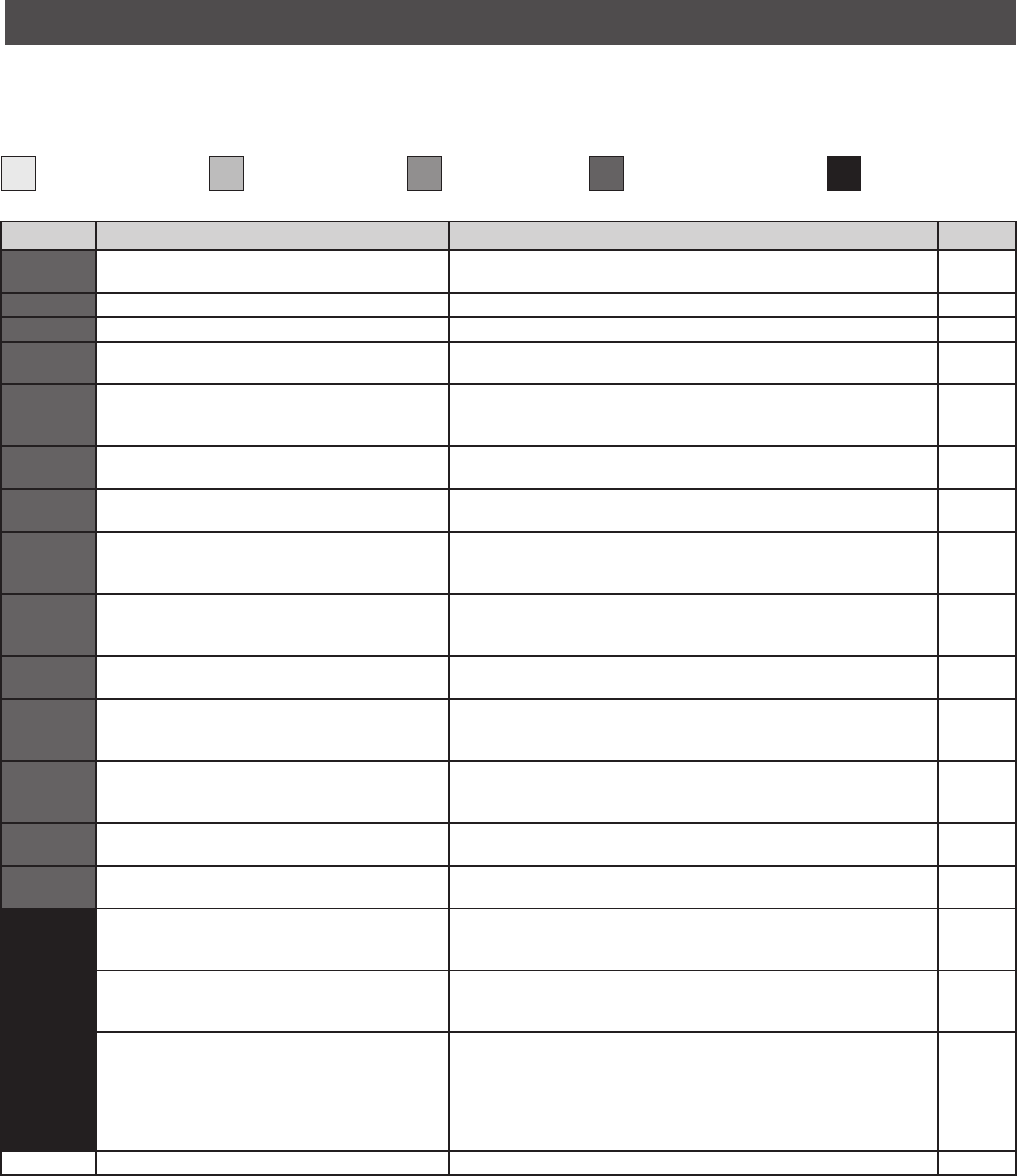
39
DIAGNOSTIC CODES continued...
TROUBLESHOOTING
Some codes are saved in the code history and some are not. If a code is not saved it will briefly appear on the display as it occurs, then disappear.
Code Meaning Solution Saved
66 OPEN EYE/EDGE held more than 3 minutes
(expansion board)
Check wired input on expansion board; check for alignment or
obstruction.
YES
67 Wireless edge triggered more than 3 minutes Check wired input for wiring issue or obstruction. YES
68 Wireless edge loss of monitoring Check wireless edge inputs. YES
69 Wireless edge triggered IF an obstruction occurred, no action required. If an obstruction did
NOT occur, check inputs and wiring.
NO
70
CLOSE EYE/INTERRUPT triggered, causing
reversal, preventing close, or resetting TTC (main
board)
IF an obstruction occurred, no action required. If an obstruction did
NOT occur, check alignment, inputs, and wiring.
NO
71 CLOSE EDGE triggered, causing reversal,
preventing close, or canceling TTC (main board)
IF an obstruction occurred, no action required. If an obstruction did
NOT occur, check alignment, inputs, and wiring.
NO
72 OPEN EYE/EDGE triggered, causing reversal or
preventing opening (main board)
IF an obstruction occurred, no action required. If an obstruction did
NOT occur, check alignment, inputs, and wiring.
NO
73
CLOSE EYE/INTERRUPT triggered, causing
reversal, preventing close, or resetting TTC
(expansion board)
IF an obstruction occurred, no action required. If an obstruction did
NOT occur, check alignment, inputs, and wiring.
NO
74
CLOSE EYE/EDGE triggered, causing reversal and
preventing close or canceling TTC (expansion
board)
IF an obstruction occurred, no action required. If an obstruction did
NOT occur, check alignment, inputs, and wiring.
NO
75 OPEN EYE/EDGE triggered, causing reversal or
preventing opening (expansion board)
IF an obstruction occurred, no action required. If an obstruction did
NOT occur, check alignment, inputs, and wiring.
NO
80
Close input (EYE/EDGE) communication fault from
other operator
Check inputs and communication method between operators, either
wired bus or radio. Ensure operator is powered. May have to erase the
wireless communication and reprogram the two operators.
YES
81
Open input (EYE/EDGE) communication fault from
other operator
Check inputs and communication method between operators, either
wired bus or radio. Ensure operator is powered. May have to erase the
wireless communication and reprogram the two operators.
YES
82 Close input (EYE/EDGE) communication fault
(expansion board)
Check the connections between the main board and the expansion
board.
YES
83 Open input (EYE/EDGE) communication fault
(expansion board)
Check the connections between the main board and the expansion
board.
YES
91
Force Reversal Look for obstruction, if no obstruction, check that the mechanical
assembly is engaged and free to move. See section on Limit and Force
Adjustment, and Obstruction Test.
YES
93
RPM / STALL Reversal Check for obstruction. If no obstruction, check the operator cable
wiring and that the operator arm is engaged and free to move. Replace
RPM assembly.
YES
95
AC motor no start condition Motor start sequence failed. If the gate and motor are NOT moving, or
moving too slow, check for an obstructed gate, binding in the
mechanism, and relay board and start capacitor connections. If the
gate and motor ARE moving, failure is due to loss of the encoder
signal. Check the encoder cup and sensor on the limit shaft, and
wiring.
YES
99 Normal Operation No action required YES
LiftMaster System Installed System Informational External Entrapment
Protection
Inherent Entrapment
Protection
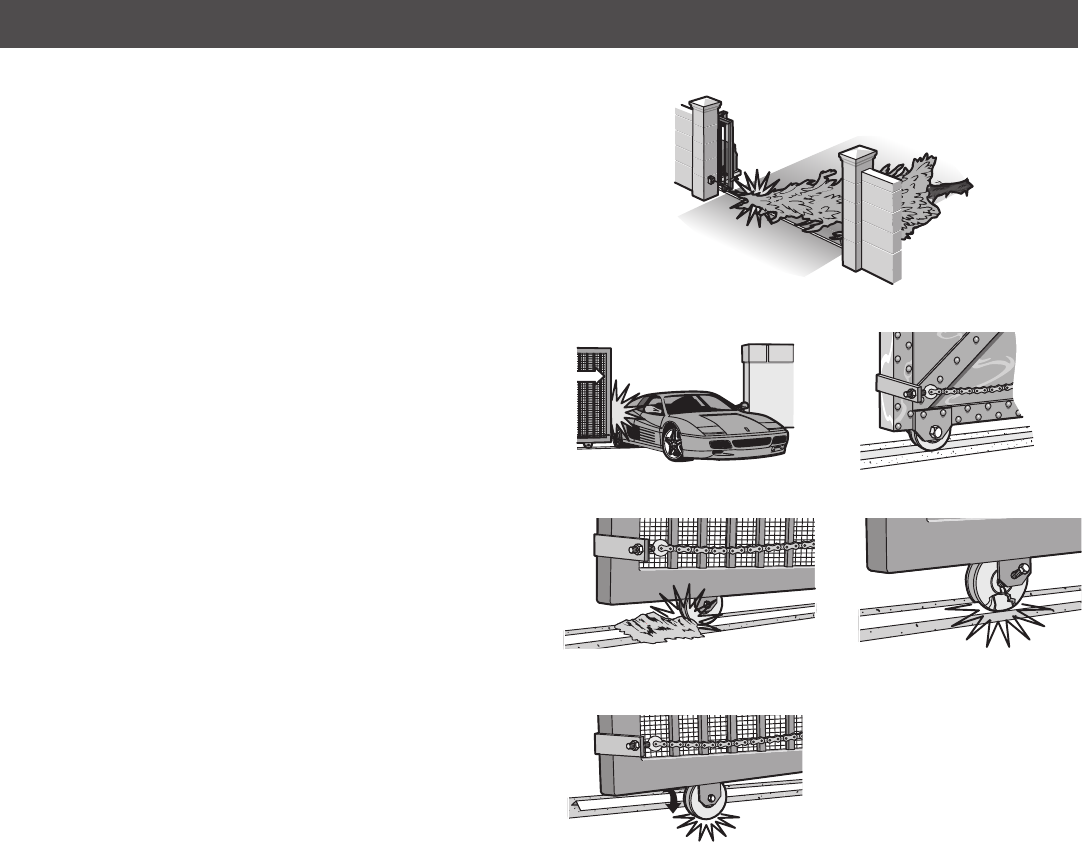
40
OPERATOR ALARM
If a contact sensor detects an obstruction twice consecutively the alarm
will sound (up to 5 minutes) and the operator will need to be reset. If a
command is given after the initial 5 minutes the operator will beep.
When the inherent force of the operator (RPM/current sensor) detects the
following (twice consecutively) the alarm will sound (up to 5 minutes)
and the operator will need to be reset:
A. The gate is hitting a wall or vehicle.
B. The gate does not meet specifications.
C. Debris is on the gate's track such as mud, rocks, dirt, etc.
D. The gate has one or more broken axles or wheels.
E. The gate wheel is off the gate rail.
Remove any obstructions. Press the reset button to shut off the alarm
and reset the operator. After the operator is reset, normal functions will
resume.
AB
CD
E
TROUBLESHOOTING

41
TROUBLESHOOTING CHART
TROUBLESHOOTING
SYMPTOM POSSIBLE CAUSES SOLUTIONS
Operator does not
run and
diagnostics display
not on.
a) No power to control board
b) Open fuse
c) Defective control board
a) Check AC power
b) Check fuses
c) Replace defective control board
Control board
powers up, but
motor does not
run.
a) Reset switch is stuck
b) Stop button active or jumper not in place
for stop circuit
c) Open or Close input active
d) Entrapment Protection Device active
e) Vehicle loop detector or probe active
f) Defective control board
a) Check reset switch
b) Check Stop button is not “stuck on”, or verify that the stop button is a
normally closed circuit, or put a jumper on the stop circuit.
c) Check all Open and Close inputs for a “stuck on” input
d) Check all Entrapment Protection Device inputs for a “stuck on” sensor
e) Check all vehicle detector inputs for a “stuck on” detector
f) Replace defective control board
Gate moves, but
cannot set correct
limits.
a) Gate does not move to a limit position
b) Gate is too difficult to move
c) Limits are set too close (slide gate
applications only)
a) Use manual disconnect, manually move gate, and ensure gate moves easily
limit to limit. Repair gate as needed.
b) Gate must move easily and freely through its entire range, limit to limit.
Repair gate as needed.
c) Ensure the gate moves at least four feet between the OPEN limit and the
CLOSE limit.
Gate does not fully
open or fully close
when setting
limits.
a) Gate does not move to a limit position
b) Gate is too difficult to move
a) Use manual disconnect, manually move gate, and ensure gate moves easily
limit to limit. Repair gate as needed.
b) Gate must move easily and freely through its entire range, limit to limit.
Repair gate as needed.
Operator does not
respond to a wired
control/command
(example: Open,
Close, SBC, etc.)
a) Check Open and Close command input LEDs
b) Stop button is active
c) Reset button is stuck
d) Entrapment Protection Device active
e) Vehicle loop detector or vehicle probe active
a) Check all Open and Close inputs for a “stuck on” input
b) Check Stop button is not “stuck on”
c) Check Reset button
d) Check all Entrapment Protection Device inputs for a “stuck on” sensor
e) Check all vehicle detector inputs for a “stuck on” detector
Operator does not
respond to a
wireless control or
transmitter
a) Check XMITTER LED when wireless
control is active
b) Stop button is active
c) Reset button is stuck
d) Poor radio reception
a) Activate wireless control and check XMITTER LED is on. Re-learn wireless
control/transmitter to control board. Replace wireless control as needed.
b) Check Stop button is not “stuck on”
c) Check Reset button
d) Check if similar wired control operates correctly. Check if wireless controls
works properly when within a few feet of operator. Check operator’s
antenna and antenna wire. Check other wireless controls or devices.
Gate stops during
travel and reverses
immediately.
a) Control (Open, Close) becoming active
b) Vehicle loop detector active
a) Check all Open and Close inputs for an active input
b) Check all vehicle detector inputs for an active detector
Gate opens, but
will not close with
transmitter or
Timer-to-Close.
a) Open control active
b) Vehicle loop detector active
c) Fire Dept input active
d) Timer-to-Close not set
e) Close Entrapment Protection Device active
a) Check all Open inputs for an active input
b) Check all vehicle detector inputs for an active detector
c) Check Fire Dept input
d) Check Timer-to-Close (TTC) setting
e) Check all Entrapment Protection Device inputs for an active sensor
Gate closes, but
will not open.
a) Vehicle loop detector active a) Check all vehicle detector inputs for an active detector
Exit loop activation
does not cause
gate to open.
a) Exit vehicle detector setup incorrectly
b) Defective Exit loop detector
a) Review Exit loop detector settings. Adjust settings as needed.
b) Replace defective Exit loop detector.
Interrupt loop does
not cause gate to
stop and reverse.
a) Vehicle detector setup incorrectly
b) Defective vehicle loop detector
a) Review Interrupt loop detector settings. Adjust settings as needed.
b) Replace defective Interrupt loop detector.

42
TROUBLESHOOTING
TROUBLESHOOTING CHART continued...
SYMPTOM POSSIBLE CAUSES SOLUTIONS
Shadow loop does
not keep gate at
open limit.
a) Vehicle detector setup incorrectly
b) Defective vehicle loop detector
a) Review Shadow loop detector settings. Adjust settings as needed.
b) Replace defective Shadow loop detector.
Obstruction in
gate's path does not
cause gate to stop
and reverse
a) Force adjustment needed a) Refer to the Adjustment section to conduct the obstruction test and perform
the proper force adjustment that is needed.
Photoelectric
sensor does not
stop or reverse
gate.
a) Incorrect photoelectric sensor wiring
b) Defective photoelectric sensor
a) Check photoelectric sensor wiring. Retest that obstructing photoelectric
sensor causes moving gate to stop, and may reverse direction.
b) Replace defective photoelectric sensor. Retest that obstructing photoelectric
sensor causes moving gate to stop, and may reverse direction.
Edge Sensor does
not stop or reverse
gate.
a) Incorrect edge sensor wiring
b) Defective edge sensor
a) Check edge sensor wiring. Retest that activating edge sensor causes moving
gate to stop and reverse direction.
b) Replace defective edge sensor. Retest that activating edge sensor causes
moving gate to stop and reverse direction.
Alarm sounds for 5
minutes or alarm
sounds with a
command.
a) Double entrapment occurred (two
obstructions within a single activation)
a) Check for cause of entrapment (obstruction) detection and correct. Press the
reset button to shut off alarm and reset the operator.
On dual-gate
system, incorrect
gate opens first or
closes first.
a) Incorrect Bipart switch setting a) Change setting of both operator’s Bipart switch settings. One operator
should have Bipart switch ON (operator that opens second) and the other
operator should have Bipart switch OFF (operator that opens first)
Alarm beeps when
running.
a) Expansion board setting
b) Constant pressure to open or close is
given
a) Pre-warning is set to "ON"
b) Constant pressure to open or closed is given
Expansion board
function not
controlling gate.
a) Defective main board to expansion
board wiring
b) Incorrect input wiring to expansion
board
c) Defective expansion board or defective
main board
a) Check main board to expansion board wiring. If required, replace wire cable.
b) Check wiring to all inputs on expansion board.
c) Replace defective expansion board or defective main board
Maglock not
working correctly.
a) Maglock wired incorrectly a) Check that Maglock is wired to N.C. and COM terminals. Check that Maglock
has power (do not power maglock from control board accessory power
terminals). If shorting lock’s NO and COM wires does not activate Maglock,
then replace Maglock or Maglock wiring (refer to Wiring Diagrams).
Solenoid lock not
working correctly.
a) Solenoid wired incorrectly a) Check that Solenoid is wired to N.O. and COM terminals. Check that Solenoid
has power (do not power solenoid from control board accessory power
terminals). If shorting lock’s NC and COM wires does not activate Solenoid,
then replace Solenoid lock or Solenoid wiring (refer to Wiring Diagrams).
Quick Close not
working correctly.
a) Quick Close setting incorrect
b) Interrupt loop detector
c) Defective Expansion board
a) Check that Quick Close setting is ON
b) Check operation of Interrupt Loop detector
c) Replace defective Expansion board
Anti-Tailgating not
working correctly.
a) Anti-Tail setting incorrect
b) Interrupt loop detector
c) Defective Expansion board
a) Check that Anti-Tail setting is ON
b) Check operation of Interrupt Loop detector
c) Replace defective Expansion board
AUX Relay not
working correctly.
a) AUX Relay setting incorrect
b) AUX Relay wiring incorrect
c) Defective Expansion board
a) Check AUX Relay switches settings
b) Check that wiring is connected to either N.O. and COM or to N.C. and COM.
c) Set AUX Relay to another setting and test. Replace defective expansion
board.
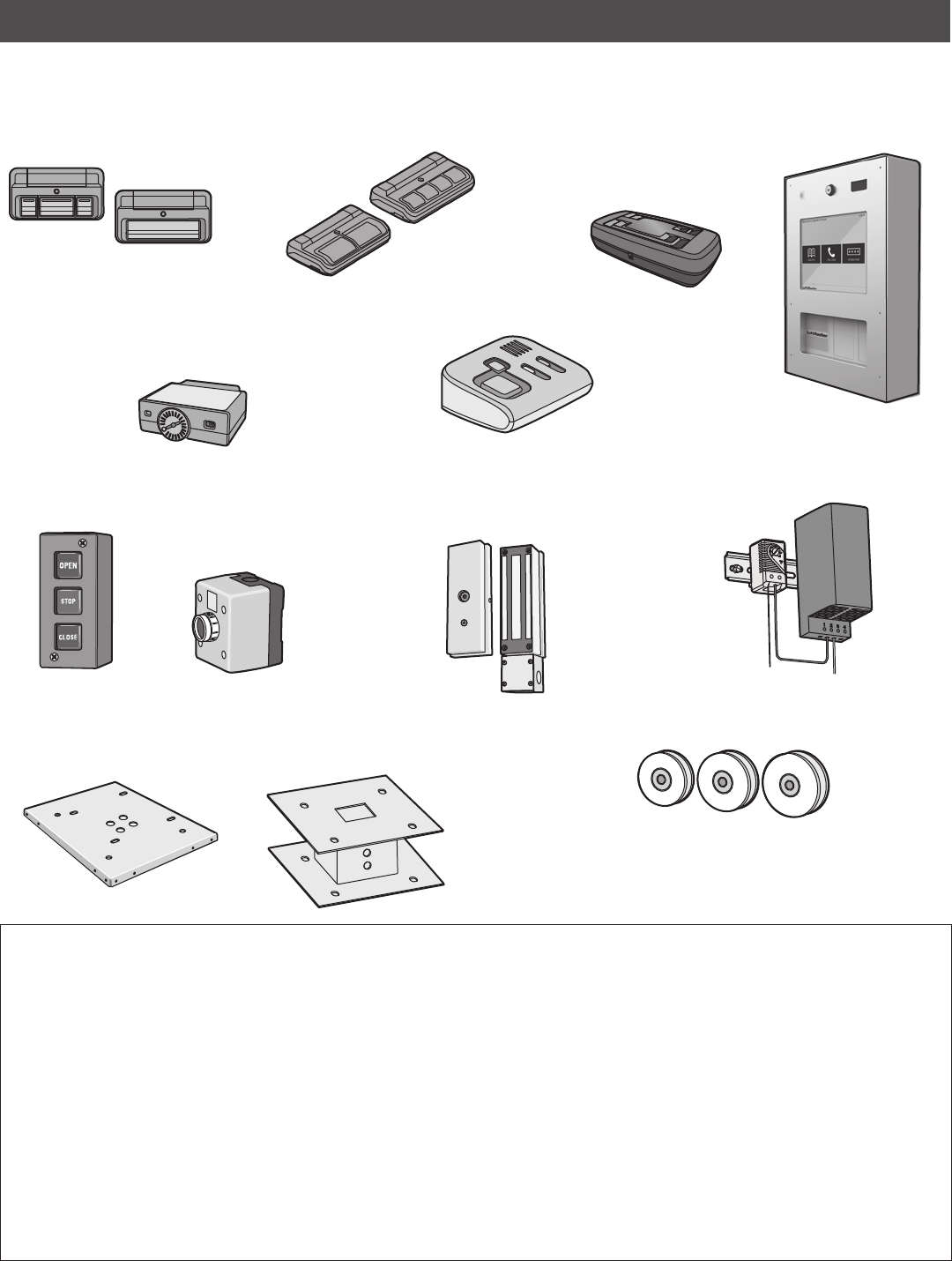
43
ACCESSORIES
PLUG IN LOOP DETECTOR
LOOPDETLM
SECURITY+ 2.0™ LEARNING REMOTE CONTROLS
892LT
894LT
UNIVERSAL REMOTE CONTROLS
813LM
811LM
VGROOVE POWER WHEELS
STOP BUTTON
AEXITP
02-103
3 BUTTON CONTROL STATION
LIFTMASTER INTERNET GATEWAY
828LM
INTERNET PROTOCOL
ACCESS CONTROL
IPAC
Model 829LM
LIFTMASTER DOOR AND GATE MONITOR
LIFTMASTER ELITE SERIES
MAGLOCK PACKAGE
MG1300RLYPKG
MSEL
STEEL STAND FOR MOUNTING
TO CONCRETE PAD
PLATE FOR POST
MOUNTING OPERATOR
MPEL
HTRNB
HEATER KIT ACCESSORY AC/DC
LONG GATE KIT (NOT SHOWN)
Adjusts gate travel up to 51 feet
Q160
ENTRAPMENT PROTECTION
LiftMaster Monitored Through Beam Photoelectric Sensor (LMTBU)
LiftMaster Monitored Retro Reflective Photoelectric Sensor (LMRRU)
LiftMaster Monitored Wireless Edge Kit (Transmitter and Receiver)
(LMWEKITU)
LiftMaster Monitored Wireless Edge Transmitter (LMWETXU)
Large Profile Monitored Edge (L50)*
Large Profile Ends Kit (pair) (L50E)**
Large Profile Channel - PVC (8 ft) (L50CHP)**
Large Profile Channel - Aluminum (8 ft) (L50CHAL)**
Small Profile Monitored Edge (S50)*
Small Profile Ends Kit (pair) (S50E)*
Small Profile Channel - PVC (8 ft) (S50CHP)*
* Available November 2015
** Available early 2016
Small Profile Channel - Aluminum (8 ft) (S50CHAL)*
Edge Cutting Tool (ETOOL)**
Wraparound Square Monitored Edge (4 ft) (WS4)**
Wraparound Square Monitored Edge (5 ft) (WS5)**
Wraparound Square Monitored Edge (6 ft) (WS6)**
Wraparound Round Monitored Edge (4 ft) (WR4)**
Wraparound Round Monitored Edge (5 ft) (WR5)**
Wraparound Round Monitored Edge (6 ft) (WR6)**
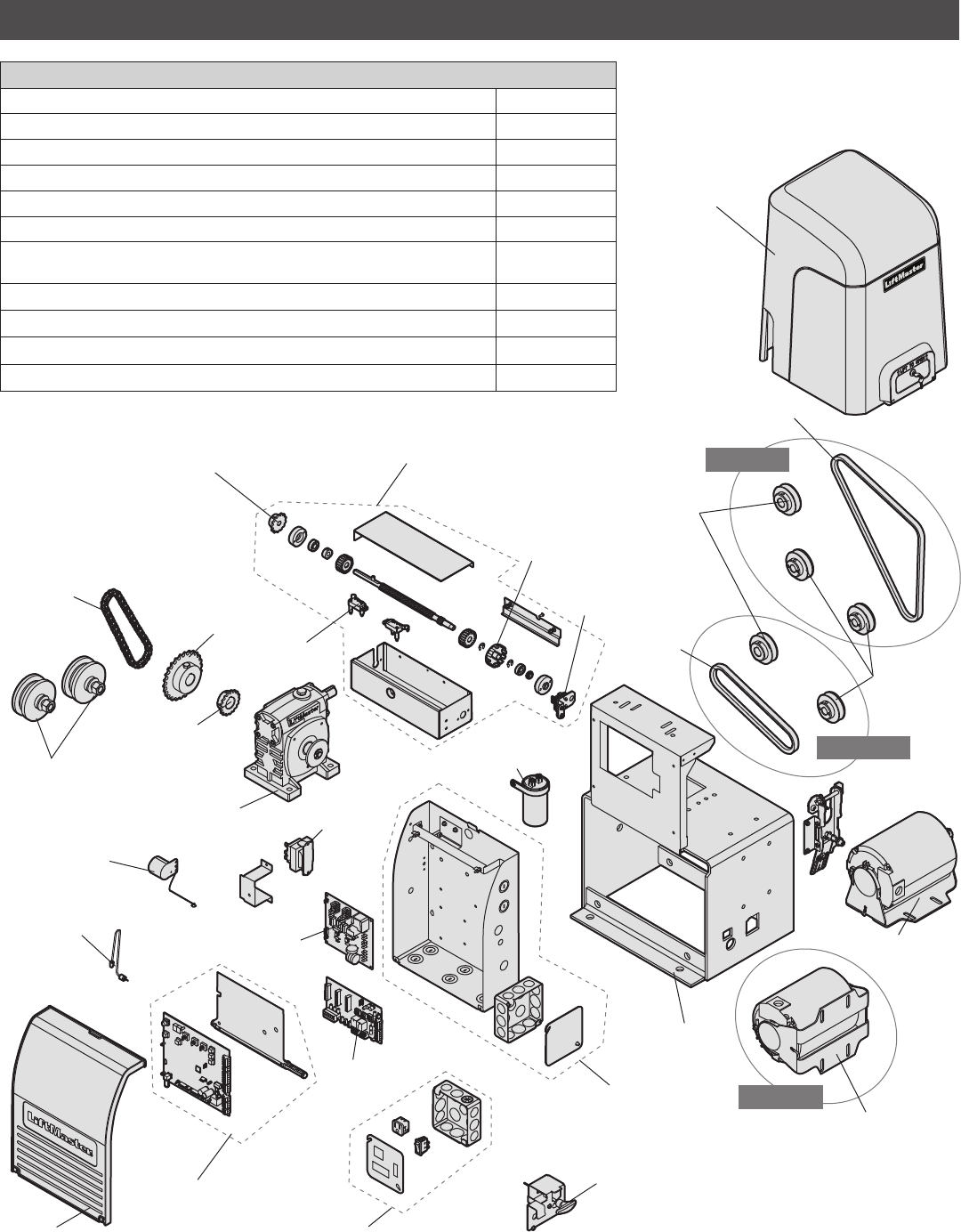
44
Cover
K77-37708
Junction Box with On/Off
Switch and Receptacle
K77-37709
Main Control Board
K1D6761-1CC
Gear Reducer and Brake
K32-37349
Alarm
K94-37461
Antenna and
Coaxial Cable
K77-37638
Dust Guard
K13-34729
Power Board,1 Phase
K1D8402-1CC
Expansion Board
K1D8387-1CC
Motor
K20-1050B-1RSX
Brake Assembly
K77-37710
Drive Belt
K16-4L230
Electrical Box
Assembly
K75-37300-1
Chassis
K73-37199
Motor Pulley
K17-50098
Limit Switch Chain
K19-35056
Drive Sprocket
K15-41B25LGH
Transformer
K21-14182
Limit Switch
K23-50099
Limit Switch Sprocket
K15-35B13AXR
Limit Switch Assembly
K76-37306
RPM CUP
K13-32087
RPM Encoder
Board
K2A0878
Limit Switch
Drive Sprocket
K15-35B17LGF
REPAIR PARTS
NOT SHOWN
#41 Chain (10 feet) 19-41240D
#40 Chain (10 feet) 19-40240D
#41 Chain (Nickel Plated) 19-41240D-NP
#41 Master Link 19-50307
#40 Master Link 19-50310
Plastic Standoffs for main control board (10 per bag) K77-37683
Wire Harnesses (main board to power board, main board to ground, main board to
transformer, and power board to transformer)
K77-37693
Wire Harness (main board to expansion board) K94-34778
Reset Switch with ID K94-37468
Hardware Kit (chain bolt and chain bracket) K77-36764
Chain Bolt K07-50637
Idler Pulley
Assembly
K75-50090
Capacitor
K29C-65AU2415
Motor
K20-1050B-1RSX
Drive Belt
K16-4L360
1 HP ONLY
1/2 HP ONLY
1 HP ONLY
Gear Pulley
K17-50095

45
7 YEAR RESIDENTIAL / 5 YEAR COMMERCIAL LIMITED WARRANTY
LiftMaster (“Seller”) warrants to the first purchaser of this product, for the structure in which this product is originally installed, that it is free from
defect in materials and/or workmanship for a period of 7 year residential/ 5 year commercial from the date of purchase [and that the SL3000U is free
from defect in materials and/or workmanship for a period of 7 year residential/ 5 year commercial from the date of purchase]. The proper operation of
this product is dependent on your compliance with the instructions regarding installation, operation, maintenance and testing. Failure to comply
strictly with those instructions will void this limited warranty in its entirety.
If, during the limited warranty period, this product appears to contain a defect covered by this limited warranty, call 1-800-528-2806, toll free, before
dismantling this product. Then send this product, pre-paid and insured, to our service center for warranty repair. You will be advised of shipping
instructions when you call. Please include a brief description of the problem and a dated proof-of-purchase receipt with any product returned for
warranty repair. Products returned to Seller for warranty repair, which upon receipt by Seller are confirmed to be defective and covered by this limited
warranty, will be repaired or replaced (at Seller’s sole option) at no cost to you and returned pre-paid. Defective parts will be repaired or replaced with
new or factory-rebuilt parts at Seller’s sole option.
ALL IMPLIED WARRANTIES FOR THE PRODUCT, INCLUDING BUT NOT LIMITED TO ANY IMPLIED WARRANTIES OF
MERCHANTABILITY AND FITNESS FOR A PARTICULAR PURPOSE, ARE LIMITED IN DURATION TO THE 7 YEAR RESIDENTIAL/ 5
YEAR COMMERCIAL LIMITED WARRANTY PERIOD SET FORTH ABOVE [EXCEPT THE IMPLIED WARRANTIES WITH RESPECT TO
THE SL3000U, WHICH ARE LIMITED IN DURATION TO THE 7 YEAR RESIDENTIAL/ 5 YEAR COMMERCIAL LIMITED WARRANTY
PERIOD FOR THE SL3000U], AND NO IMPLIED WARRANTIES WILL EXIST OR APPLY AFTER SUCH PERIOD. Some states do not
allow limitations on how long an implied warranty lasts, so the above limitation may not apply to you. THIS LIMITED
WARRANTY DOES NOT COVER NON-DEFECT DAMAGE, DAMAGE CAUSED BY IMPROPER INSTALLATION, OPERATION OR CARE
(INCLUDING, BUT NOT LIMITED TO ABUSE, MISUSE, FAILURE TO PROVIDE REASONABLE AND NECESSARY MAINTENANCE,
UNAUTHORIZED REPAIRS OR ANY ALTERATIONS TO THIS PRODUCT), LABOR CHARGES FOR REINSTALLING A REPAIRED OR
REPLACED UNIT, OR REPLACEMENT OF BATTERIES.
THIS LIMITED WARRANTY DOES NOT COVER ANY PROBLEMS WITH, OR RELATING TO, THE GATE OR GATE HARDWARE,
INCLUDING BUT NOT LIMITED TO THE GATE SPRINGS, GATE ROLLERS, GATE ALIGNMENT OR HINGES. THIS LIMITED
WARRANTY ALSO DOES NOT COVER ANY PROBLEMS CAUSED BY INTERFERENCE. ANY SERVICE CALL THAT DETERMINES THE
PROBLEM HAS BEEN CAUSED BY ANY OF THESE ITEMS COULD RESULT IN A FEE TO YOU.
UNDER NO CIRCUMSTANCES SHALL SELLER BE LIABLE FOR CONSEQUENTIAL, INCIDENTAL OR SPECIAL DAMAGES ARISING IN
CONNECTION WITH USE, OR INABILITY TO USE, THIS PRODUCT. IN NO EVENT SHALL SELLER’S LIABILITY FOR BREACH OF
WARRANTY, BREACH OF CONTRACT, NEGLIGENCE OR STRICT LIABILITY EXCEED THE COST OF THE PRODUCT COVERED
HEREBY. NO PERSON IS AUTHORIZED TO ASSUME FOR US ANY OTHER LIABILITY IN CONNECTION WITH THE SALE OF THIS
PRODUCT.
Some states do not allow the exclusion or limitation of consequential, incidental or special damages, so the above limitation or exclusion may not
apply to you. This limited warranty gives you specific legal rights, and you may also have other rights which vary from state to state.
WARRANTY
01-37920 © 2015, LiftMaster – All Rights Reserved
845 Larch Avenue
Elmhurst, Illinois 60126-1196
LiftMaster.com